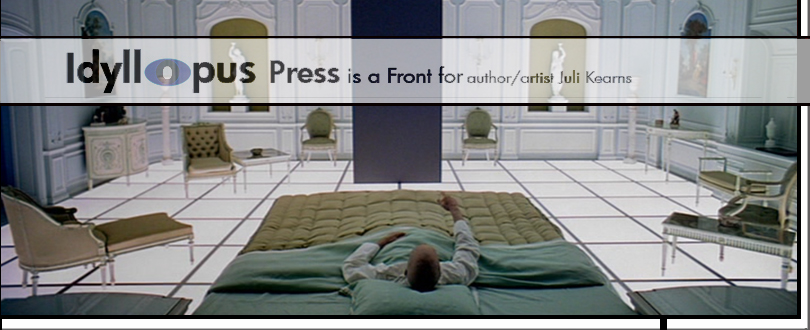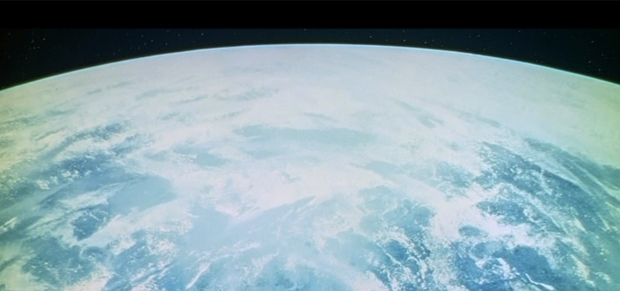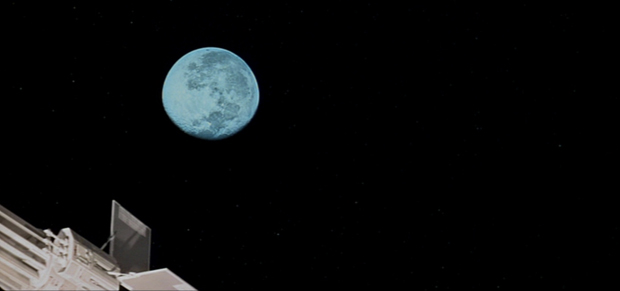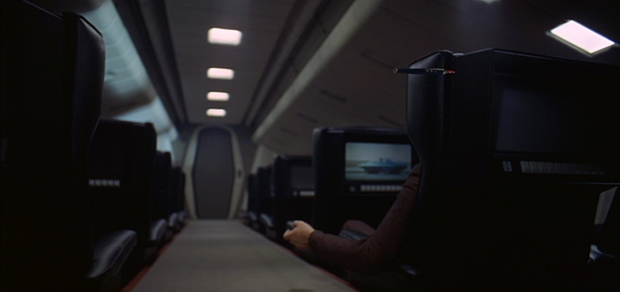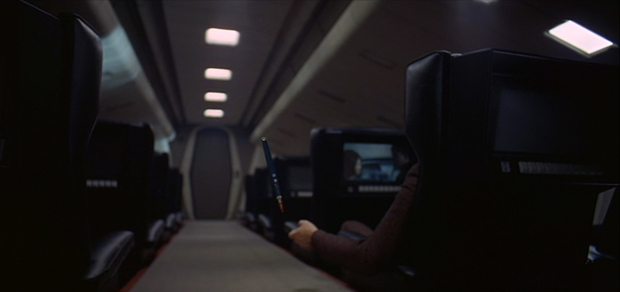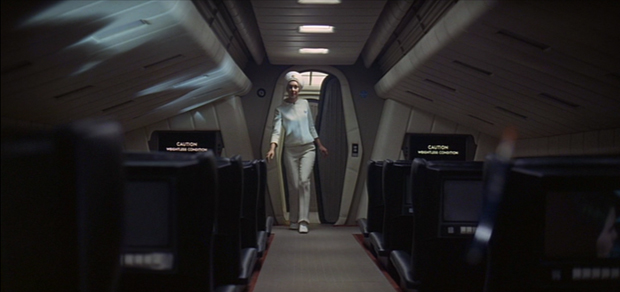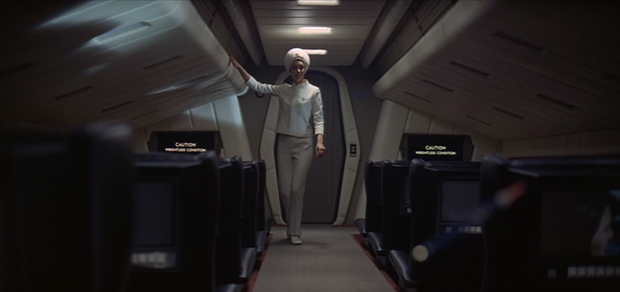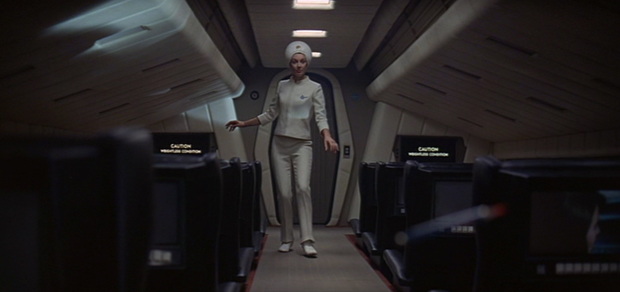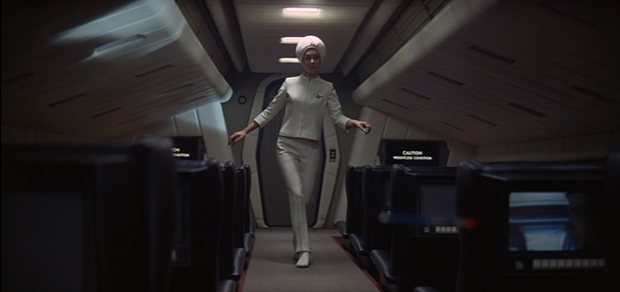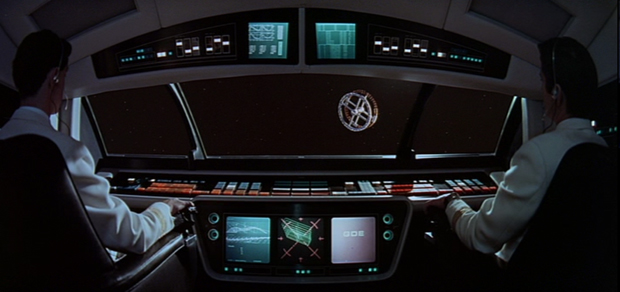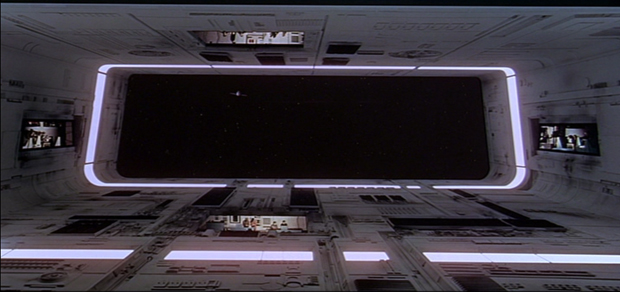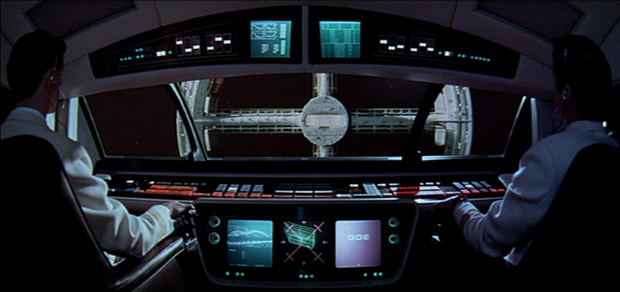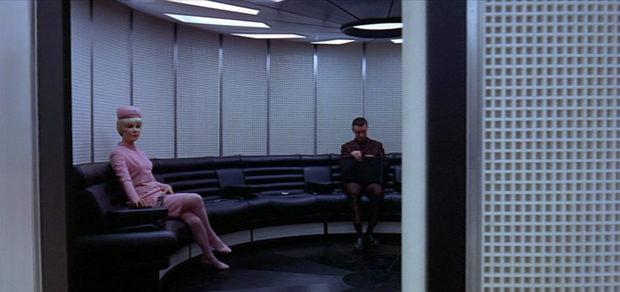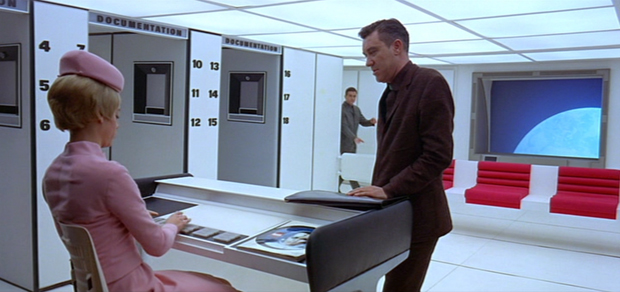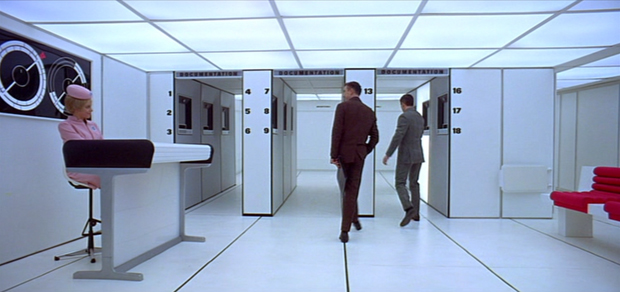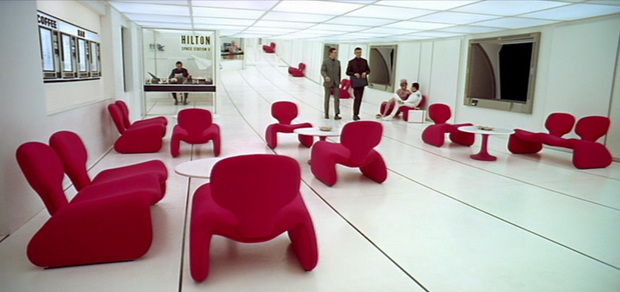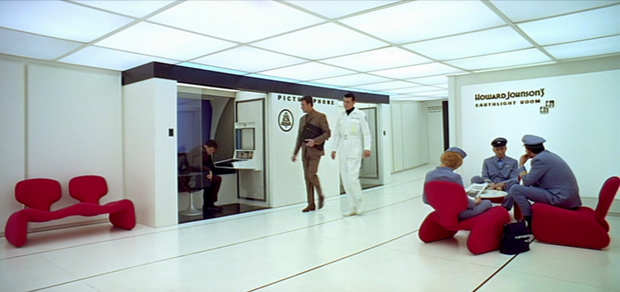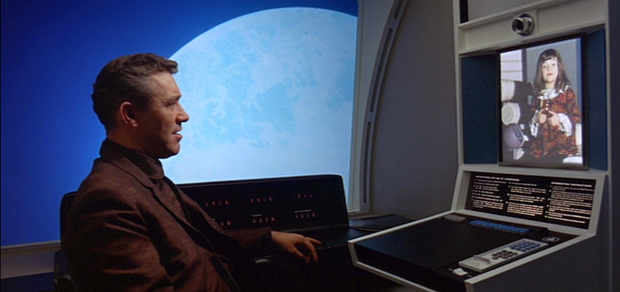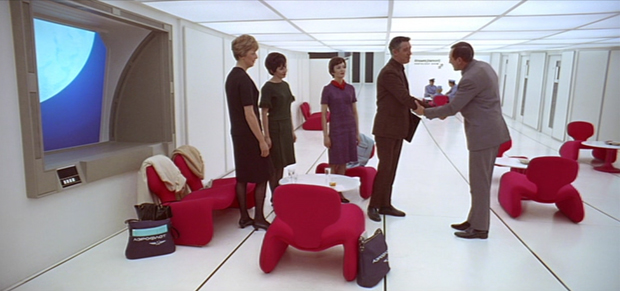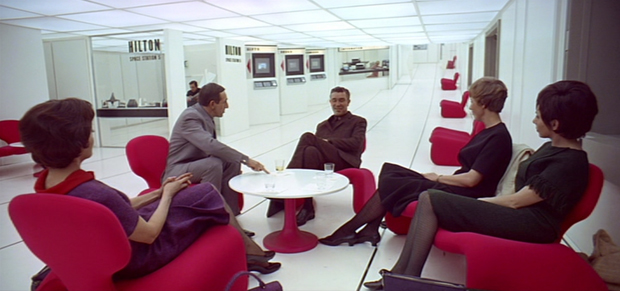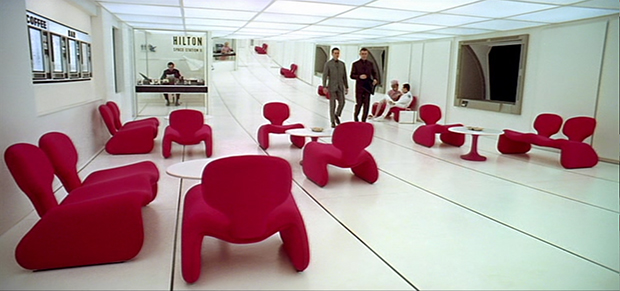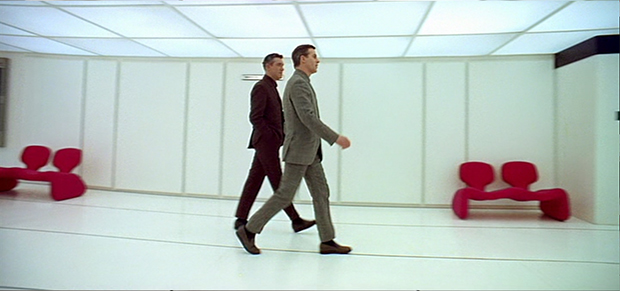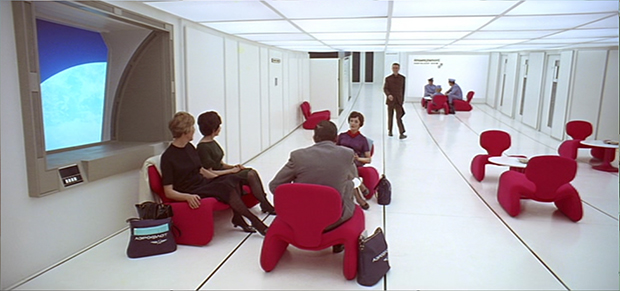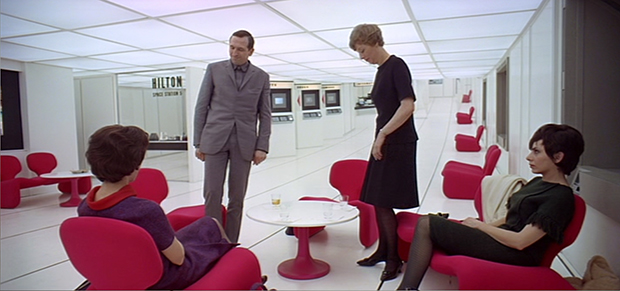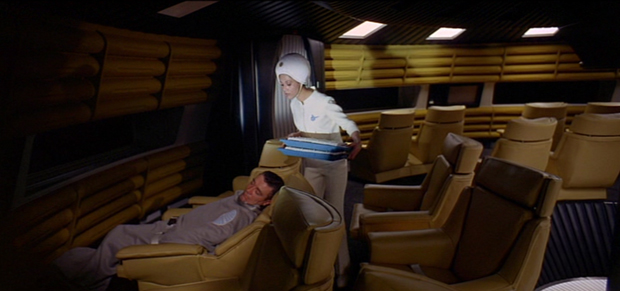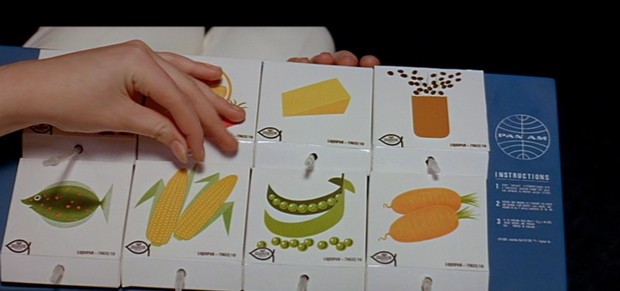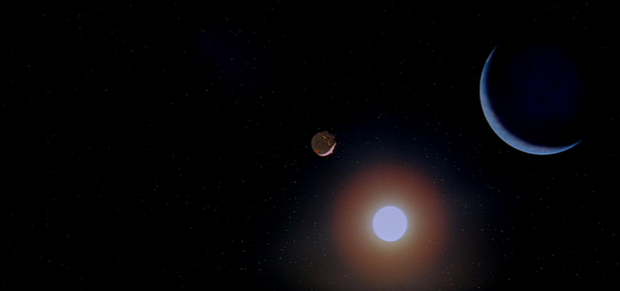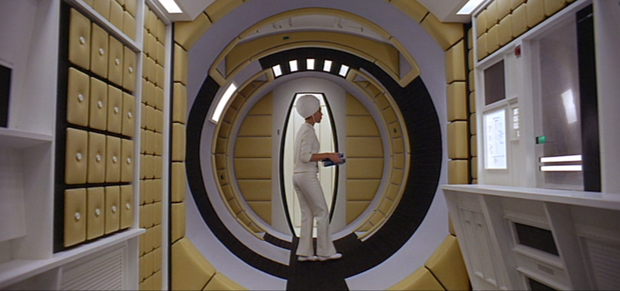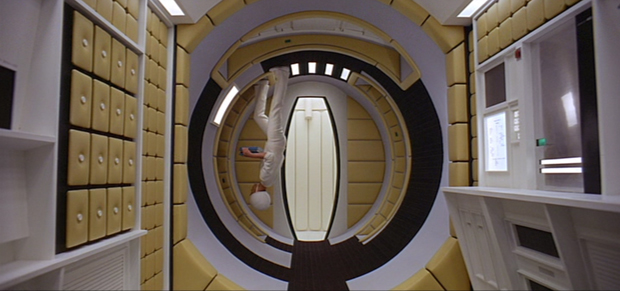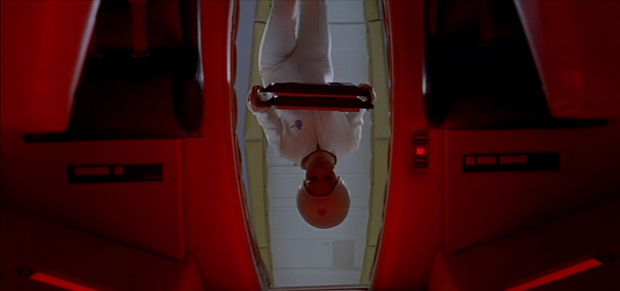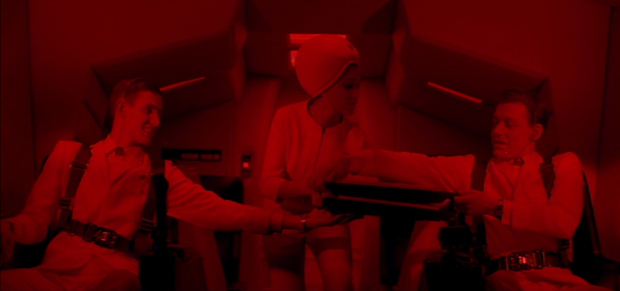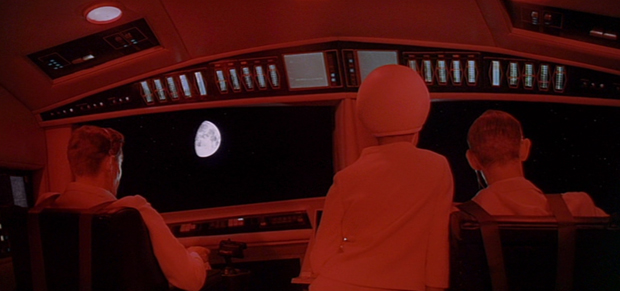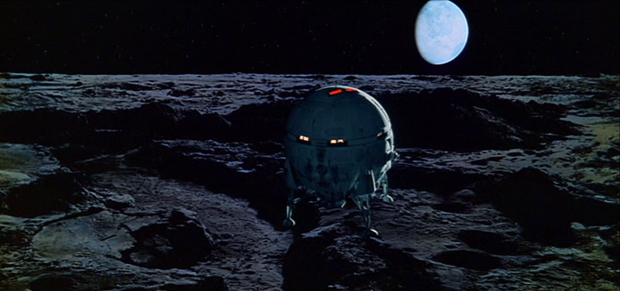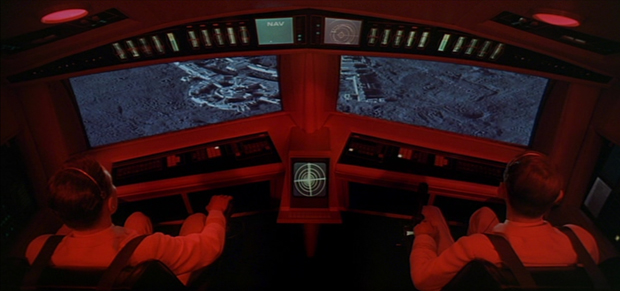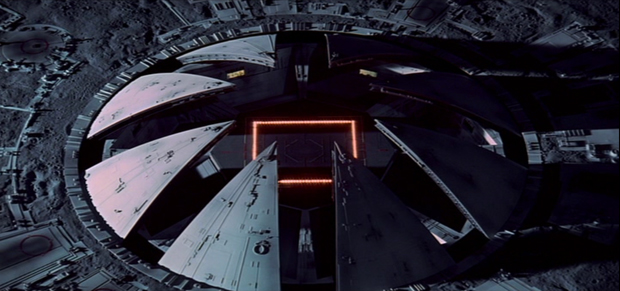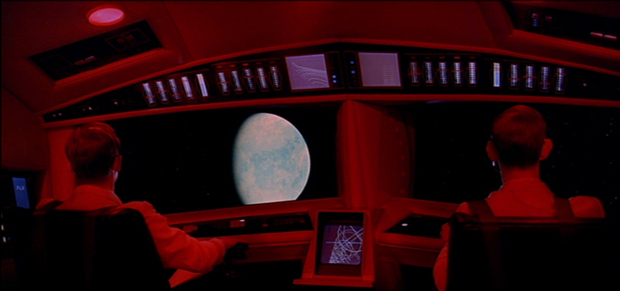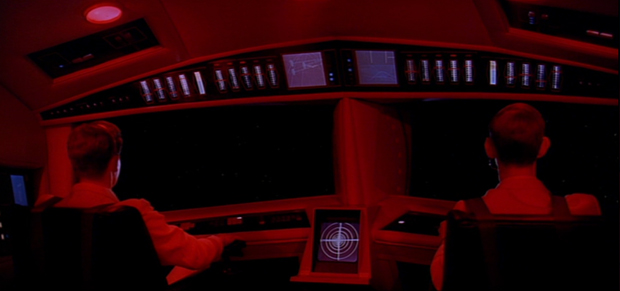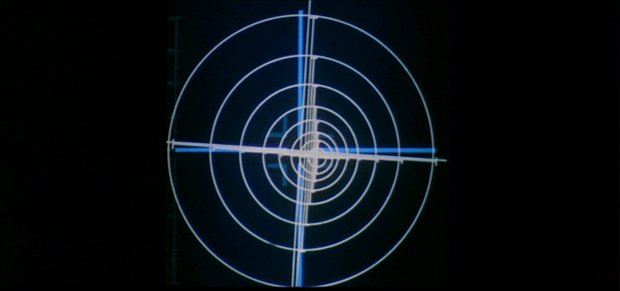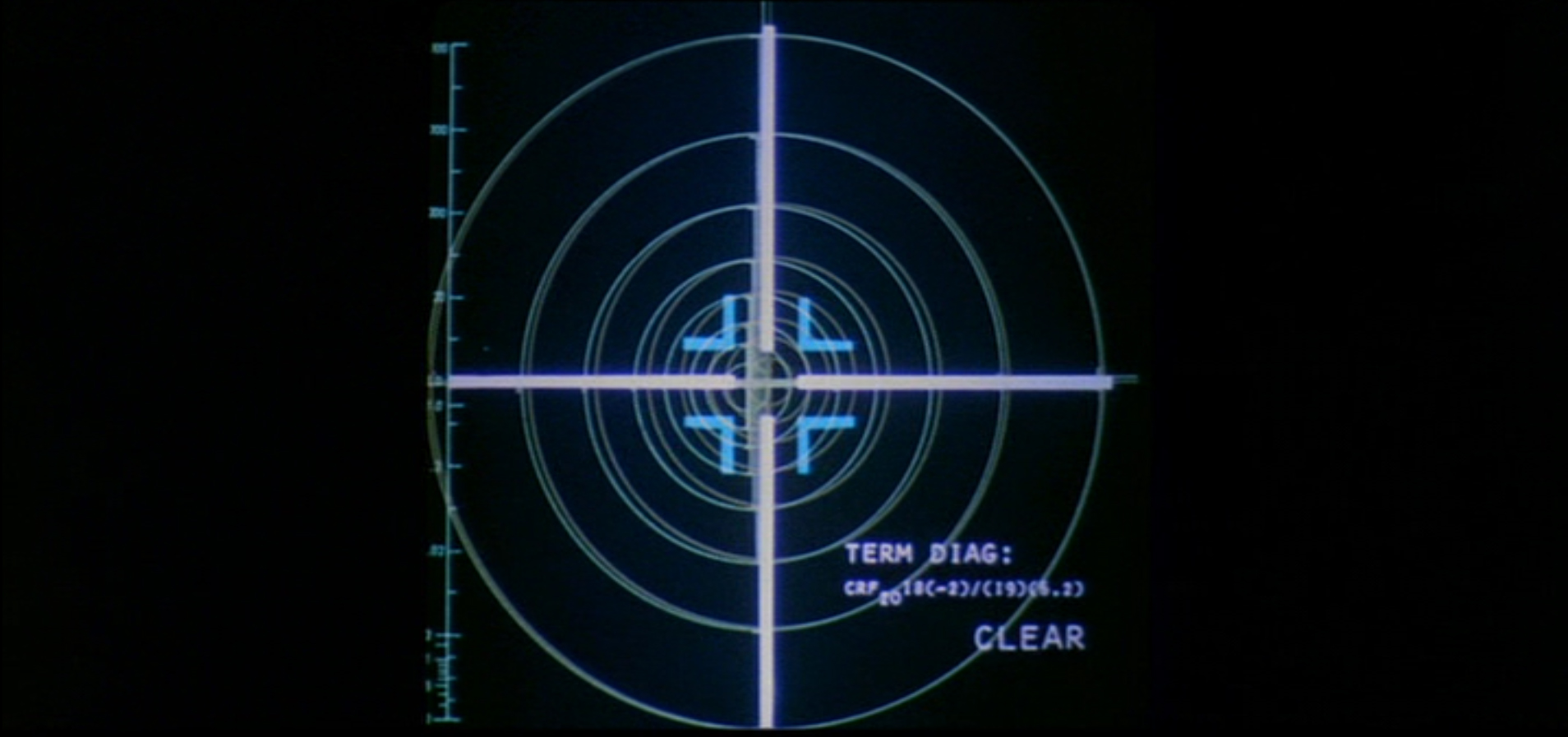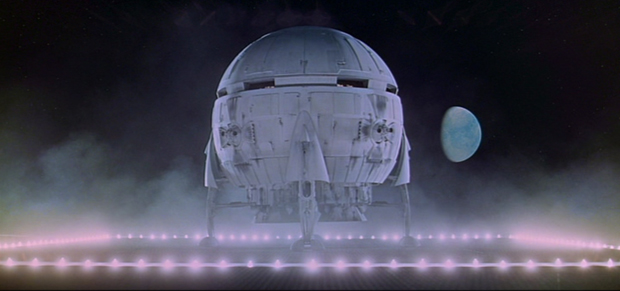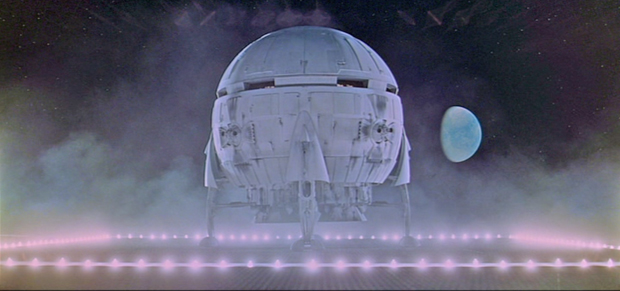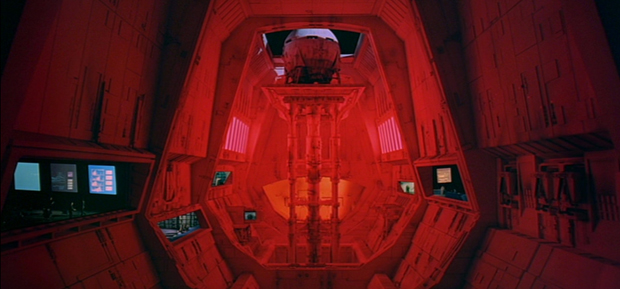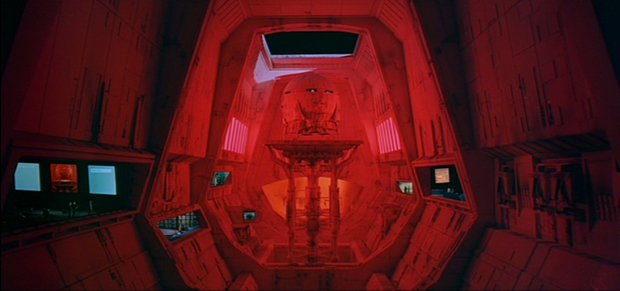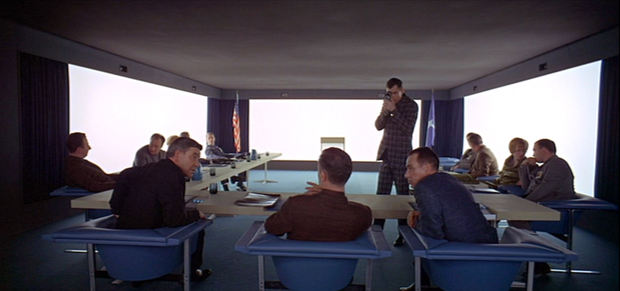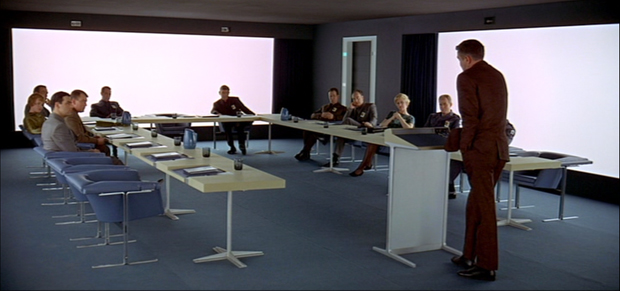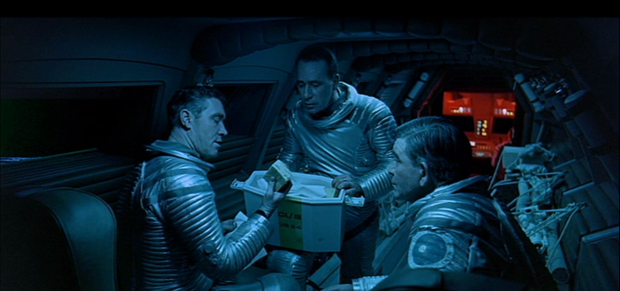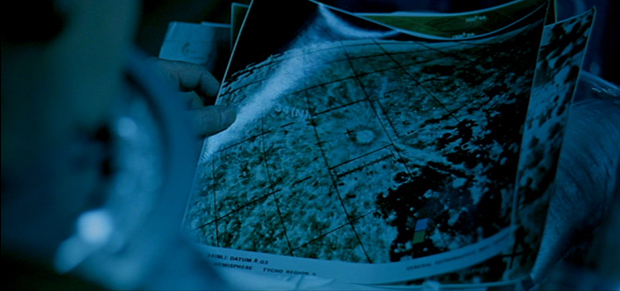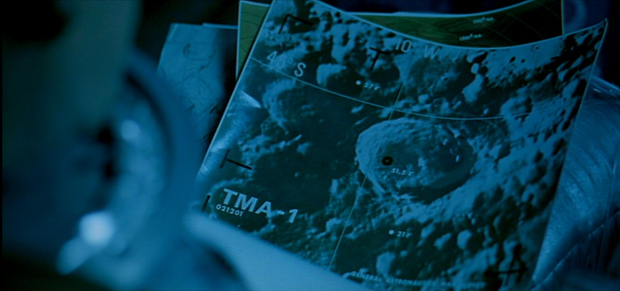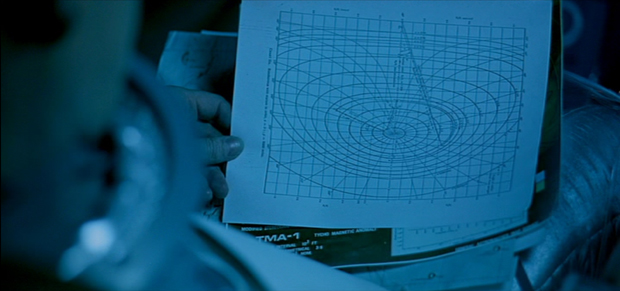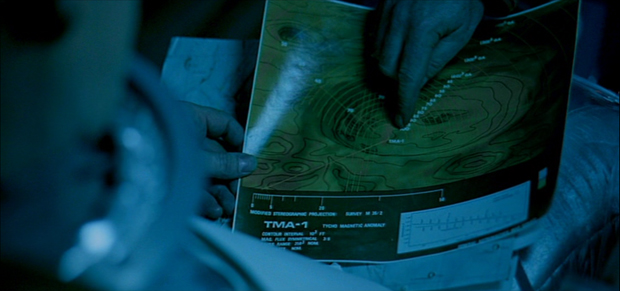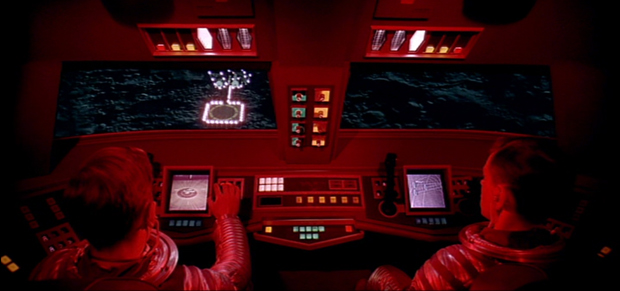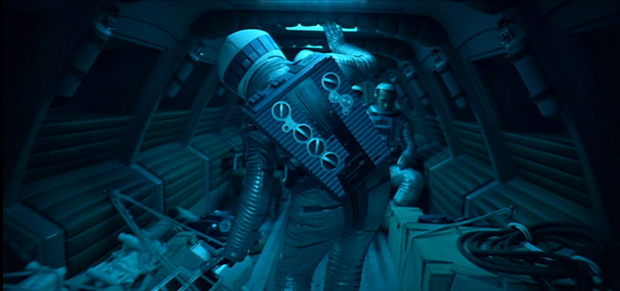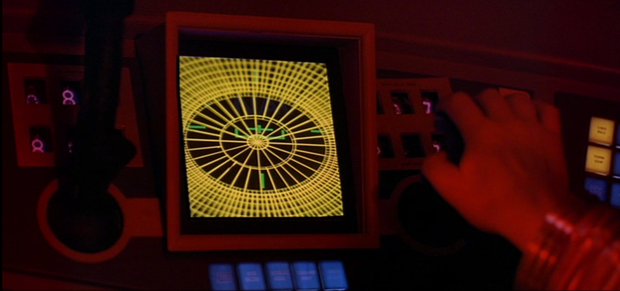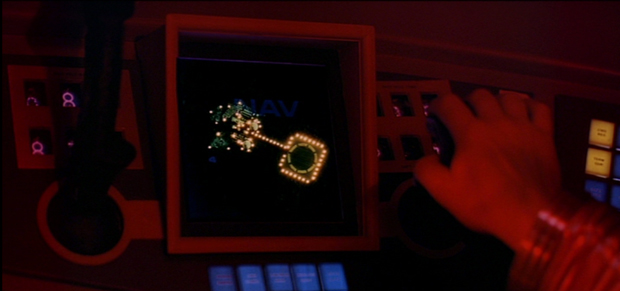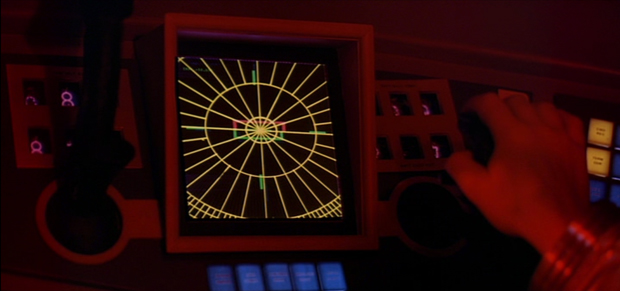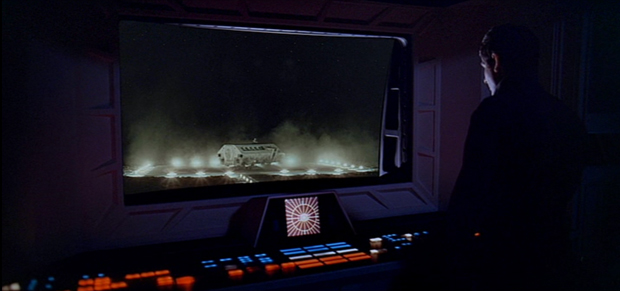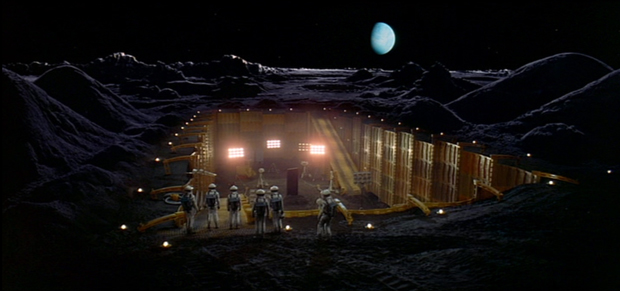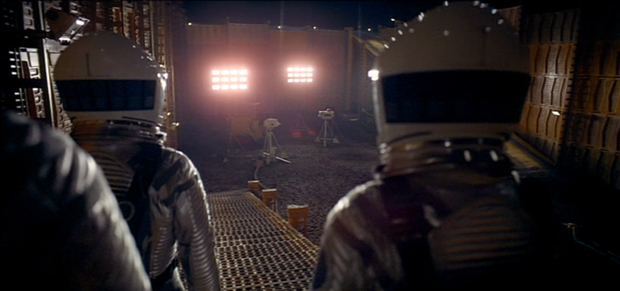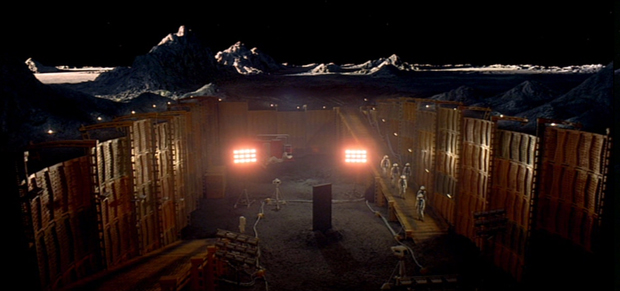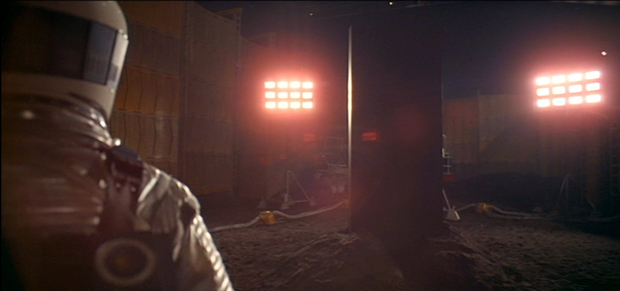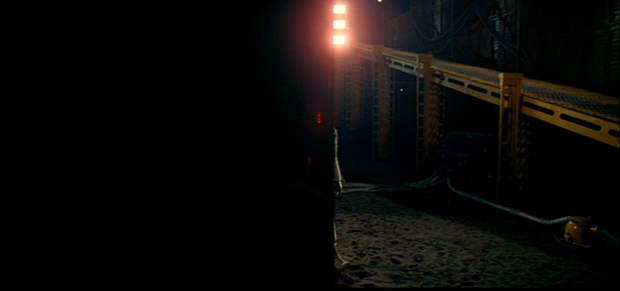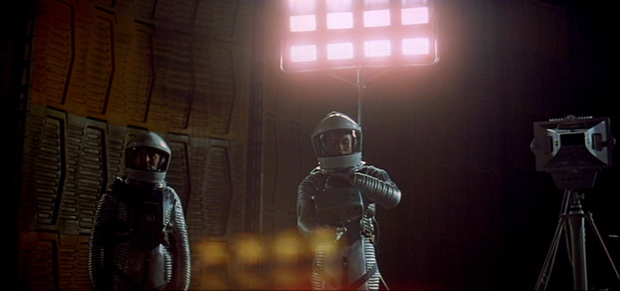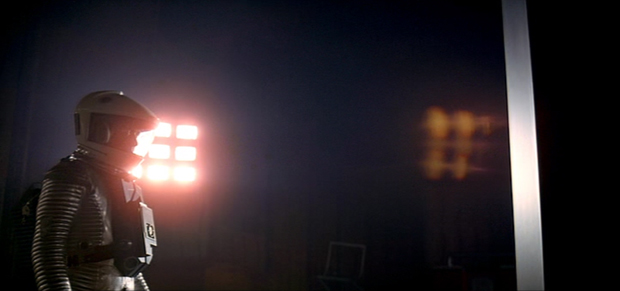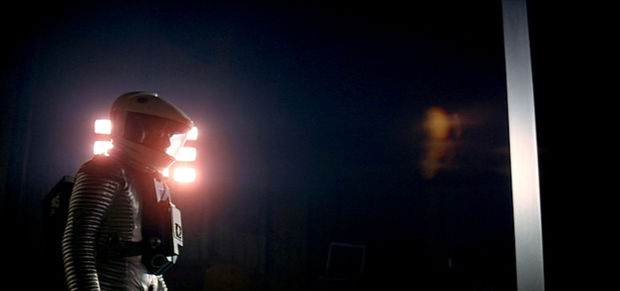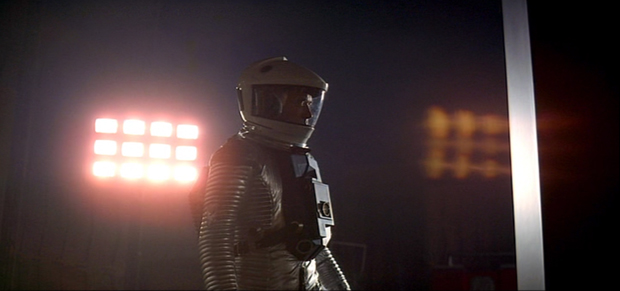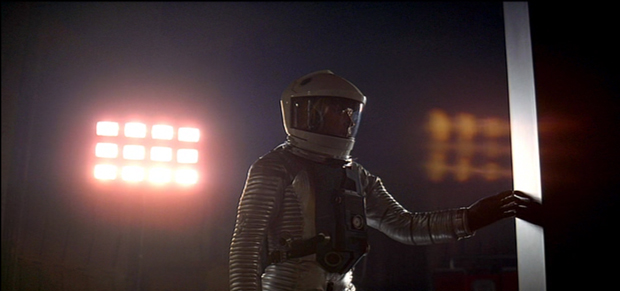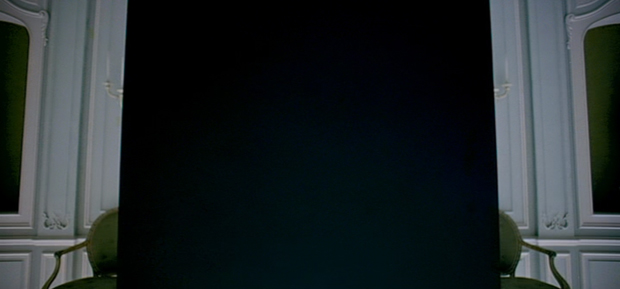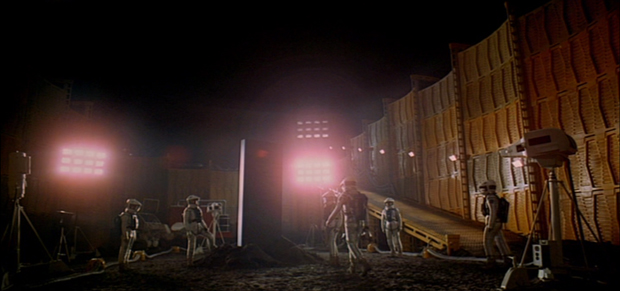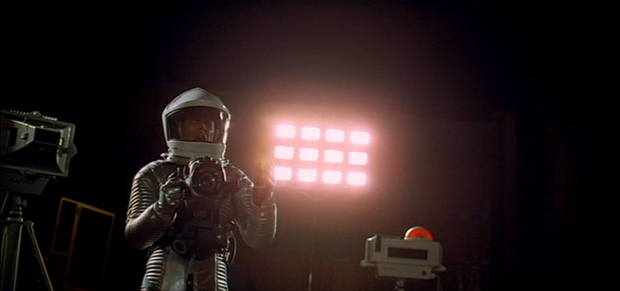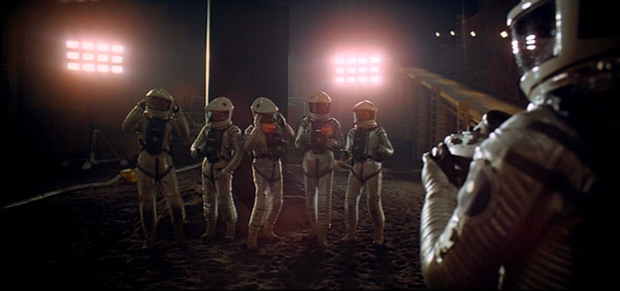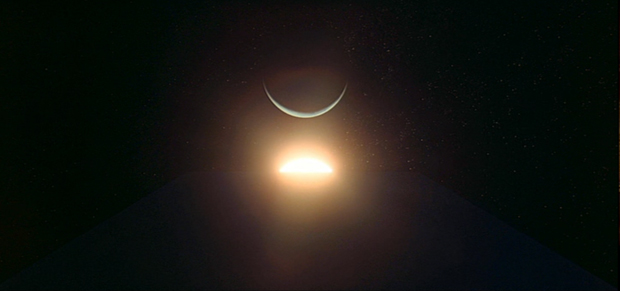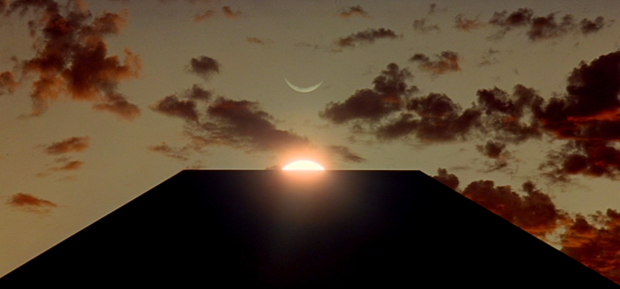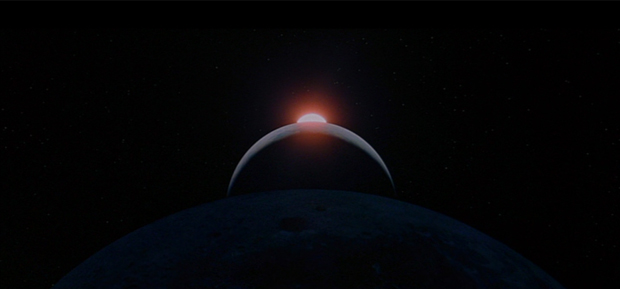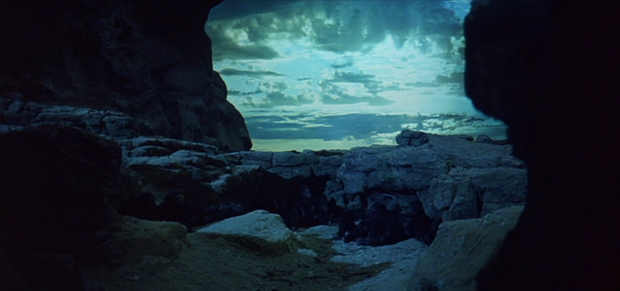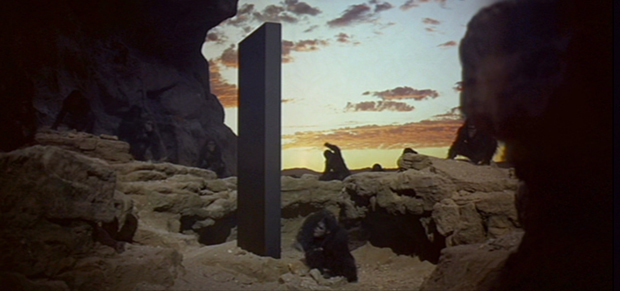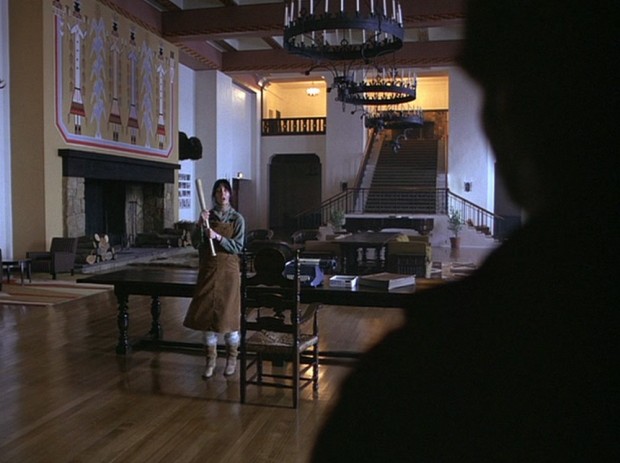STANLEY KUBRICK'S FILM
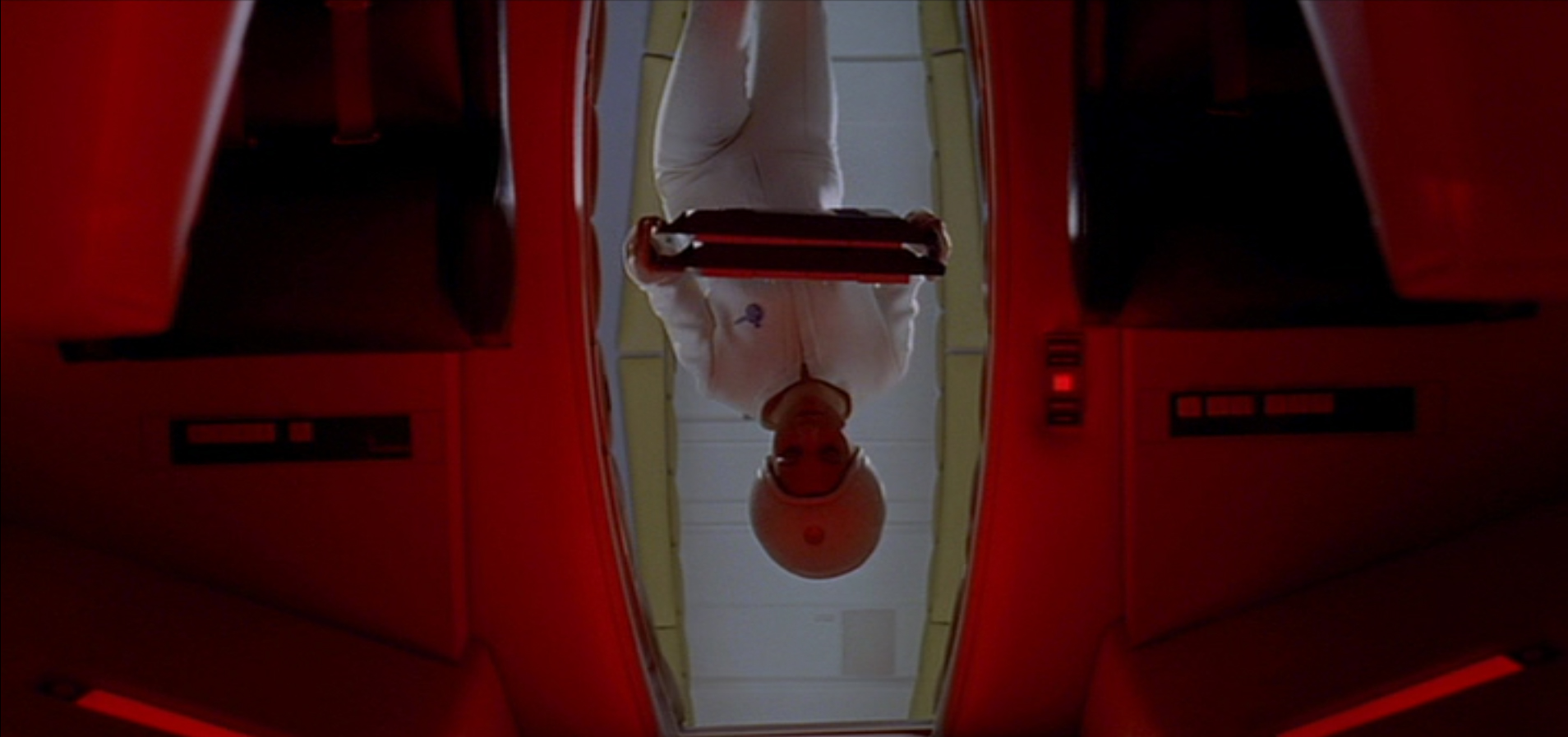
Go to TOC for this film ( (which has also a statement on purpose and manner of analysis and a disclaimer as to caveat emptor and my knowing anything authoritatively, which I do not, but I do try to not know earnestly, with some discretion, and considerable thought).
PART TWO
TOC and Supplemental Posts | Part 1 | Part 2 | Part 3 | Part 4 | Part 5 | Films Home
LINKS TO SECTIONS OF THE ANALYSIS ON THIS PAGE:
To the Moon -- The Eternal Return Waltz, Shots 106 through 126
Johann Strauss II's "The Blue Danube Waltz" and doubling in the choice of music from Johann and Richard. The bone becoming the satellite. The red-tipped floating pen maintains a clockwise rotation (most things change). Ancient hominids and their anxiety over vulnerability while asleep as opposed the sleeping Heywood. Notes on the reversal in spin of the space station. The pilots of the Orion and doubling. .
See You on the Way Back -- Meeting with the Russians, Shots 127 through 144
It's morning for Heywood and Miller so this is, in effect, another "sunrise" section, as with the Dawn of Man. Differences of spin of the earth through the windows of Space Station 5. Helen, the Odyssey, and "Paris Match". Symslov named for chess player Vasily Smyslov. The conversation as chess. Smyslov and the hotel clerk in Eyes Wide Shut. Smyslov as Barry's rival in Barry Lyndon.
The Moving Djinn Chairs
Djinn and the protean morphing theme in Kubrick's films.
The Bushbaby
The Eternal Return Waltz Redux and Aries Vistas, Shots 145 through 169
Karate and the refinement of fighting to an art form. Food (divorced from its origins) and the language of symbol. The stewardess revolves 180 degrees to enter the pilot cabin when instead she should have revolved 90 degrees and exited through the portal foremost to the camera. Shot 159 giving a clear view of the pilot windows at the "top" of the craft, their orientation about a 90 degree turn from the passenger area rather than a 180 degree turn. The pilots of the Aires 1b as doubles, just as in the earlier Orion shuttle. It is impossible for the pilots to have a view of the moon and the base as they do in 162 as their windows are actually pointed away at an 180 degree angle. The antrhopomorphizing of the Aries.
Karate and the Open Hand
Grave Potential for Cultural Shock and Social Disorientation -- The Conference, Shots 170 through 181
The 12 conference attendees and the last supper (continuing with the them of the Requiem Mass). The structure of the shots of the speech.
Isolation
Communion, Shots 182 through 205
Ligeti's "Lux Aeterna" (eternal light" and the communion antiphon for the Requiem Mass. Anamnesis and the paschal mystery. TMA, Tycho Magnetic Anomaly, relationship to "magnesia" and the philosopher's stone. The seeming 5th person in on the moonbus.
The Crater, Tycho, and the Communion Cup and How We're Not Seeing What We Believe We're Seeing
Heywood's Encounter
Tycho and "bull's eye". Orion and the hunter. Aries and the ram of the vernal equinox golden fleece, the Reborn Sun. Relationship of the crater Tycho to the waterhole in the Dawn of Man section. Orientation confusions approaching the monolith so that shot 211 feels like 206. Monolith as the "between", a dividing line. The photographer as the first to react to the piercing sound. The impossible convergence above the monolith (we have alreasdy seen the earth was just above the lunar horizon and the sun way off to the side).
The Photographer
TO THE MOON
THE ETERNAL RETURN WALTZ
SKIP ALL THIS AND TAKE ME TO THE TL;DR WRAP-UP AT THE END OF THE PAGE.
106 Cut from the bone to a U.S. satellite. (19:53)
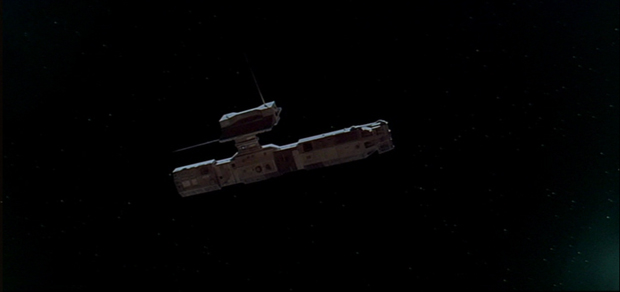
Panning right from the satellite we see the glowing blue-white marble of Earth, as "The Blue Danube Waltz" of Johann Strauss II begins with its extended introduction. Richard Strauss' "Also Spake Zarathustra" had begun the Dawn of Man section, bringing in the idea of eternal recurrence. Kubrick, I would think, is playing on that idea of the eternal recurrence, at least his version of it, by opening both these sections with music by a Strauss (unrelated individuals). This becomes the eternal return waltz.
We also have the eternal recurrence--and metamorphosis and evolutions--with the bone, flung into the air at the end of the "Dawn of Man" section, becoming here the satellite. The revelation had via the monolith, which had resulted in tool use for procuring food, for protection, for aggression, has advanced through one technological achievement after another until finally the descendants of early hominids have slipped Earth's boundaries, have traveled into space--and, depending on one's understanding if these are nuclear satellites or not, has also brought humankind to the brink of wholesale catastrophe. Kubrick initially conceived of these satellites as nuclear then abandoned that idea, but this initial intention sometimes persists in the public's comprehension of the film. The movie never gives any indication of the status of the satellites and so the viewer who knows nothing of this history has no reason but to see them as representations of advanced technology. There is tension between the Russians and Heywood on the space station, reflecting the 1960s Cold War between two leading powers of the time, but there is also obviously friendship, which was, in the late 1960s, unimaginable in the minds of most. Not only is a treaty referred to, but Heywood and his Russian friend will speak of hoping to visit with each other back on earth. We've no idea of the state of earth or of civilization, but never is there ever any expression, either, of impending doom so some may even have the utopian impression that technological advancement of this degree has meant also intelligent handling of earth's resources and the attainment of a good and equitable living standard for all. As there is no dramatic sense of impending doom, though obviously there is tension between the Russians and Heywood due secrecy over what is happening on the moon, diplomacy between nations is thus made pretty well of no consequence to the film and releases the movie to concentrate on matters other than political. In other words, this is not a film about America winning some space race. It's a film about people as in Dave and Frank do not represent America. They represent humanity.
The satellites do, however, following up tribal conflict in The Dawn of Man section, acknowledge and present modern tribes as a continuing consequence of very ancient bonds and fractioning. The conscious individual as opposed to group control is a mainstay concern in Kubrick's filmography.
107 The German satellite enters from the right. (20:08)
108 The sun rounds the edge of the earth as a German satellite soars into view from the right. (20:17)
109 The earth criss-crossed by dense and scattered clouds fills the screen, and the camera pans up to a Chinese satellite entering from the right. (20:27)
In some of these shots, we have the earth fringed with a yellow tint. Kubrick's choice of an earth with surface greatly obscured by crosscurrent shreddings of clouds reminds of the seeming brushwork type strokes added to the skies in The Dawn of Man section, and I would hazard this is intentional, that the brush-stroke web covering the skies in so many of the Dawn of Man shots should be recalled as we now view the earth from above but are distanced from it emotionally by a quite similar webbing that ensures we are unable to distinguish Earth's continents. If we were able to pick out continents, we would automatically pick out the familiar, home. Kubrick keeps us from doing that. Home is moving into the skies. The earth is unknowable, hidden.
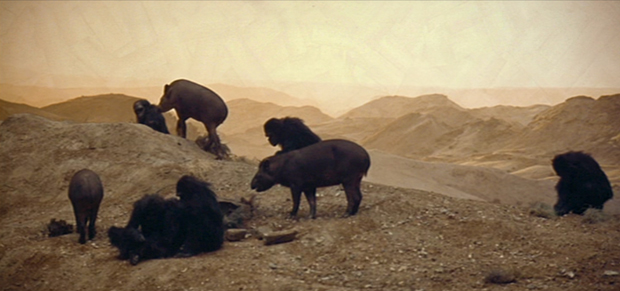
The green vignetting tint that was most notably sometimes viewed in the waterhole sections is sometimes used in our views of Earth.
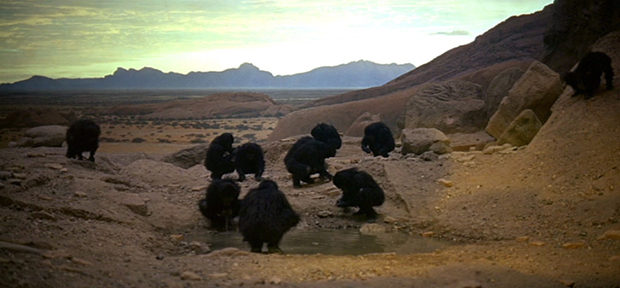
As the Chinese satellite passes, the camera continuing its pan up, we see the moon.
The heavily clouded earth is distinct from but rather resembles its satellite moon.
The Dawn of Man section opened with sunrises in which the earth was in dark shadow, and then a museum of natural history diorama theater of earth that at times more resembled a Mars landscape, very little greenery observed. Kubrick, making the leap from that to man freed from the bounds of earth, living in the sky, removes us from the history of earth as a nurturing mother terra, so much so that later when Heywood is speaking with a Russian friend she relates that her husband is doing underwater research, again not on mother earth but would likely be housed in the underwater equivalent of the space station. I may be wrong, but I believe with the exception of when Heywood speaks with his daughter on the phone, we never see any continents lurking beneath the clouds, no greens or browns, no lights of cities. When Heywood speaks with his daughter on the phone she is inside so we see no landscapes, and later when the astronauts on Discover One view transmissions from earth these are again all interior shots. No trees, no grass. Only once do we briefly glimpse a photographic image of an earth landscape, and it is easily passed over. Never do we see any of the astronauts feast on "natural" food or tend plants. There is no greenery on the space ships or shuttles. All is manmade. We have become beings surrounded only by products of our imagination.
Kubrick revisits in all his films the theme of destiny as versus individual freedom of will. With the hominids, prior the monolith, there was little to take them out of destiny's control. After the appearance of the monolith, we have the seeming advent of freedom of will and its technological domination of environment. In A Clockwork Orange the conflict of destiny and freedom of will was partly expressed in Alex's plight, the ability to physically express his destructive freedom of will subdued by brainwashing by the state, but that freedom of will was also in question as he was already seemingly subject to destiny's design, which begged the question of the nature of evil. Alexander, the author and former victim of Alex (also, symbolically his father and a twin aspect of self) who rebels against brainwashing, upon finding out Alex's identity is certainly not interested in his well-being, intent on using Alex's brainwashing to destroy him. What is good and what is evil, what is freedom of will and what is destiny, reverses again and again until there is no distinguishing between the two.
Shot 106 | Shot 107 |
 |  |
Shot 108 | Shot 109 |
 |  |
110 Cut to the twin wheels of Space Station 5, the earth to the right. (20:52)
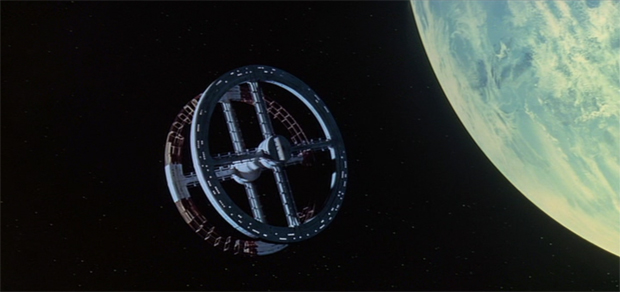
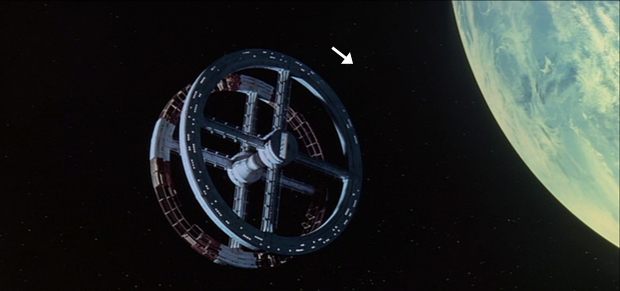
As the camera zooms in on the slowly turning twin wheels of the space station, the introduction to the waltz strengthens then is subdued again.
The wheels of the space station are turning clock-wise in this scene.
111 Partial shot of Earth on the left. (21:22)
The camera pans right to the Pan-American Orion III space shuttle ferrying Heywood Floyd to the Space Station. The introduction ending, the first of the Blue Danube waltz themes begins.
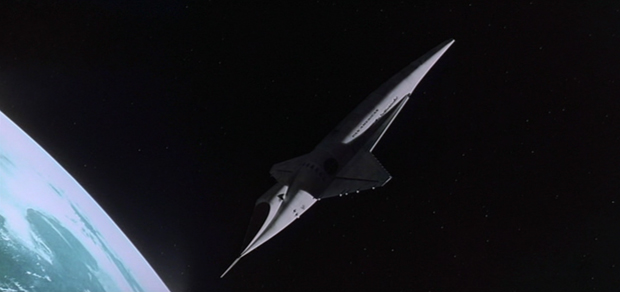
112 Interior of the Panam shuttle showing, from the rear, Heywood seated with his arm floating over the aisle. (21:42)
On a television before Heywood is observed a car. A red-tipped pen floats into view from above, screen right, and the camera shifts to focus on it as, on the television screen, the camera zooms in on the car and falls out of focus. The image on the television screen then changes to a woman speaking with a man.
Unlike the spin of many things, the pen will maintain a clockwise rotation throughout the scene and does not change, unless we count when it stands absolutely still.
A lot of attention is given the switch from the bone weapon to the satellite in shots 105 to 106, but there is perhaps a reason for our having Heywood's arm isolated from his body here, and the pen floating into view from above, for Heywood's suspended arm and the tumbling pen remind also of the hominid with his bone that he throws into the air.
When the pen is nearly perpendicular to the floor, cut.
113 Opposing view of Heywood and the pen. We realize he is asleep. (22:04)
The pen is in continual motion before and after this shot, but in this shot, which extends for some seconds, the pen never moves. It rests parallel the floor.
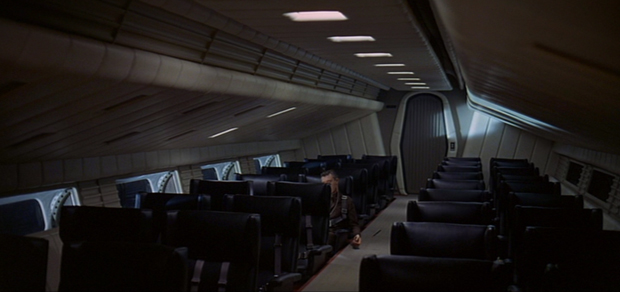
114 CU of the pen from the rear, the far door out of focus. (22:11)
The pen is horizontal, and rather than suspended so its ends point from door to door as in the previous shot, parallel the long edges of the aisle, it is perpendicular the aisle. As the pen revolves to a vertical position, the far door opens and the pen falls out of focus while a flight attendant entering the chamber comes into focus. She shuts the door behind her.
115 The Close-up side view of the flight attendant's feet, the hermetic winged Pan-am logo on the side of her Grip Shoes, and her stirrup pants. (22:22)
It's somewhat amusing that the Pan-Am logo on the grip shoes is adorned with wings, though their grip design is to keep her from flying off.
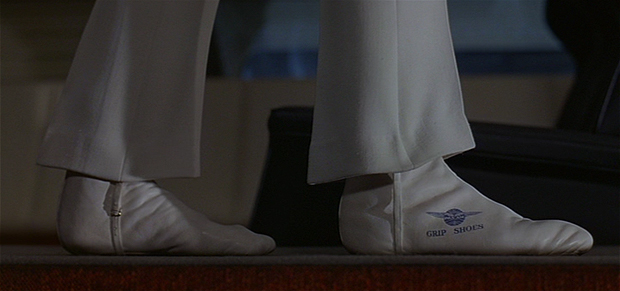
116 Long shot of the flight attendant again as in shot 114. (22:28)
Kubrick returning from the focus on the attendant's shoes, we see the spin of the pen continues its clockwise motion.
Walking down the aisle, as the attendant passes under each ceiling light the ceiling is illuminated then goes dark again when she is between the ceiling lamps. It's an interesting effect, perhaps caused by the lamp reflecting off the bright white of her hat.
We see also the play of light and shadow on the ceiling overhanging the left bank of seats continually changes somehow in accordance with the light entering the right windows.
She catches the pen.
117 Low 3/4 view of Heywood from the front and the flight attendant. (22:46)
She slips the pen into his left (our right) top jacket pocket, shuts off the television and walks off screen left, the camera remaining on Heywood and his floating arm.
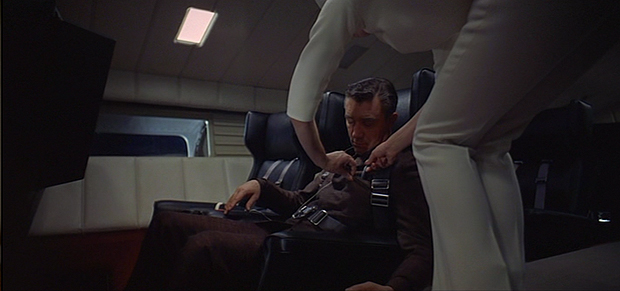
In the Dawn of Man opening, prior the appearance of the monolith, we had the hominids depicted as unable to comfortably rest due the fear of the creatures of the night, such as the panther. But when introducing modern humans, Kubrick depicts them in a particularly vulnerable situation, Heywood being asleep, dependent on the flight attendant and unconscious of her care. This happens not just once, but twice, and seems significant due HAL's later murder of the astronauts in their state of hibernation during which they're utterly dependent upon the computer.
118 Shot of the shuttle on the left, Space Station 5, and the moon on the right. (22:56)
The wheels are turning clockwise.
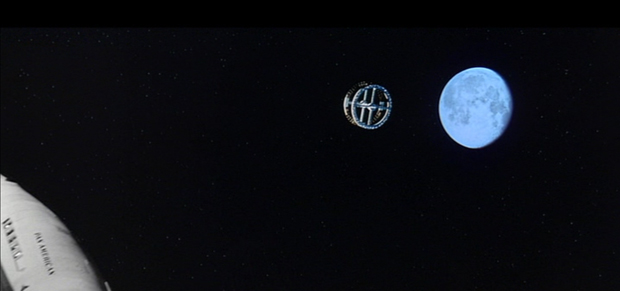
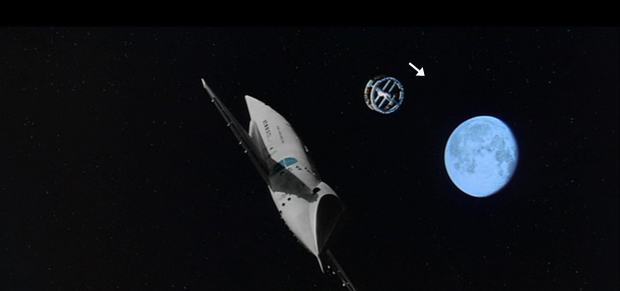
119 Earth on screen left. Space Station 5 revolves into view from screen right. (23:04)
The shuttle follows, pursuing the Space Station.
In shots 118 and 110 the wheels were spinning clockwise. They now spin counter clockwise.
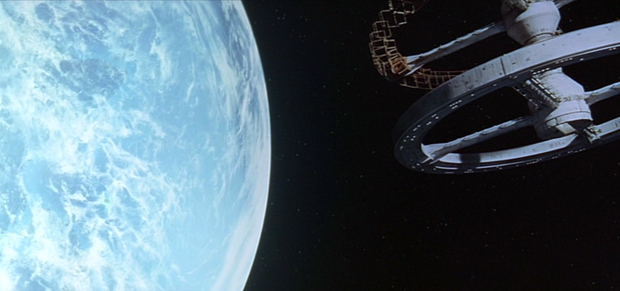
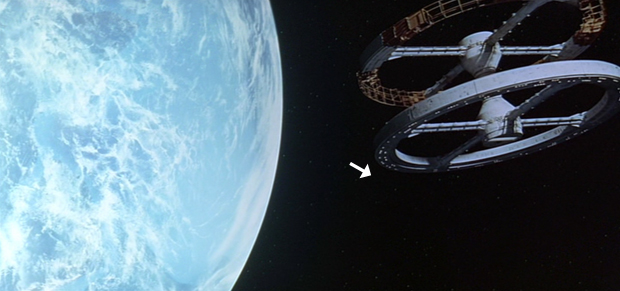
If we flip the scene horizontally so the earth is in relationship as it was to the Space Station in shot 110, then we have the wheels spinning clockwise again.
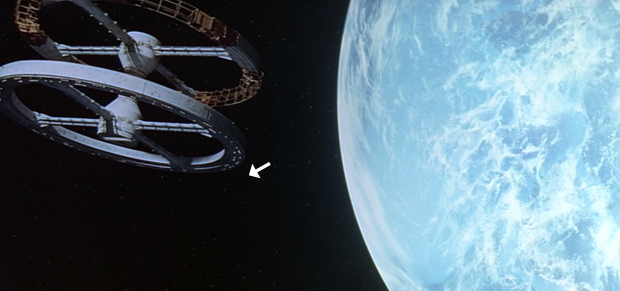
I'm paying (what may seem very tedious) attention to the rotation because of Kubrick's propensity for playing with orientation and changing it. One of the best and obvious examples is the maze in The Shining which shifts orientation. The famous elevator door out of which blood spills also flips horizontally between the time when Wendy first views it and the flood of blood. The hallway in which we view the elevator, however, does not reverse, only the doors are flipped. So these reversals in his films are intentional. We've already observed how in the Dawn of Man sequence we had a horizontal flipping of the landscape when the monolith is first viewed by the hominids, the frontal screen projection afterward returning to its previous "normal" orientation. But when you have these reversals, it becomes kind of impossible to say which is the "normal" orientation or if there even is one, though in the case of the elevator door in The Shining when the doors flip horizontally for the blood pouring out of them, the hallway remaining the same, we can certainly hazard that is not the normal orientation.
One thing the changes in orientation may accomplish is to keep the audience ungrounded. If familiarity breeds, if not contempt, then ennui, the lack of linearity in the background, while the viewer is focused on foreground elements, means a subtle, inconspicuous, continuous, unconscious destabalization riding beneath the story line.
120 The flight deck of the shuttle with the Space Station in view. Two pilots in white sit right and left. (23:34)
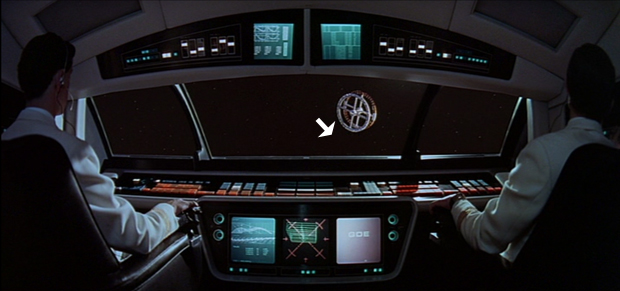
The spin is counter-clockwise as in shot 119. The controls show the counter-clockwise spin and when the targeted landing pad reaches horizontal, cut away to the next shot.
Why the switch from clockwise to counter-clockwise at this point? I would suggest we look at the scene and how pilots are near mirror images of one another. Not exact mirror images, no, but we have certainly a doubling. They are near indistinguishable.
121 Close-up of the controls and video screens between the two pilots. (23:44)
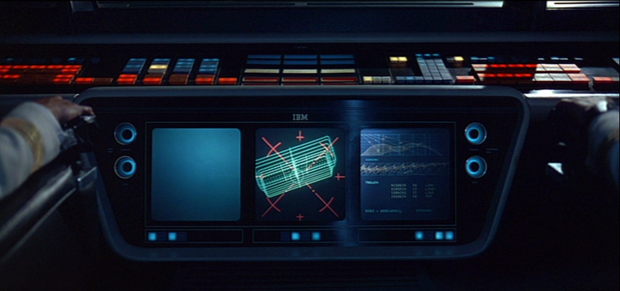
122 Shot from the interior landing area of Space Station 5, first showing only the sky and then zooming out to show the ship. (23:52)
The shuttle enters view from lower screen right. As the camera continues to zoom out we see top, bottom, left and right, windows through which we view activity in the ship. This space station, viewed from the interior, Kubrick has chosen to show in a stable view rather than spinning.
123 The Shuttle lining up with Space Station 5. (24:35)
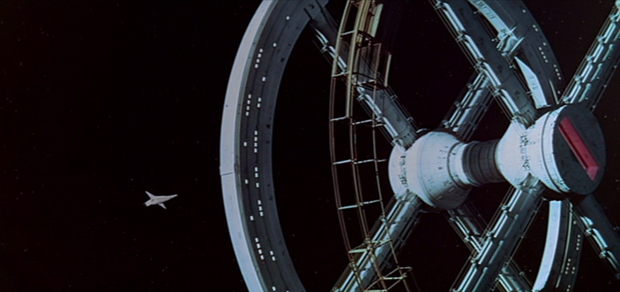
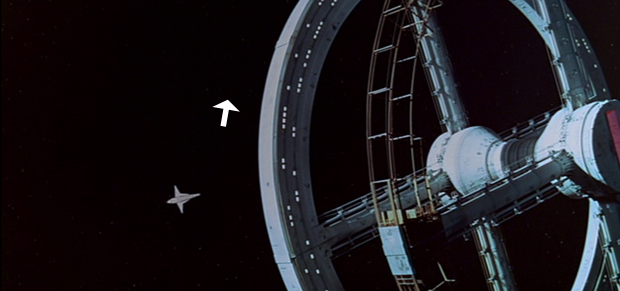
The spin is now is again clockwise in relationship to us, but it actually remains counter-clockwise in relationship to the pilots on the Orion. Based on what we had observed in the first shot (5) of Space Station 5, it should always be spinning clockwise when we observe it from the landing pad side, and counter-clockwise when observed from the other side with the red window opposite the landing pad in the craft.
With these reversals we would do well to keep in mind the revolution of the bone at the end of the Dawn of Man section, how it was spinning clockwise as it rose, then we had a break, then returned to it still rising but spinning counter-clockwise, then continuing to spin counter-clockwise during its descent. The space station has gone from the same clockwise to counter-clockwise spin.
124 The flight deck again of the shuttle. (24:56)
This is a repeat of shot 120. As with shot 120, it cuts away right before the box in the bottom, middle screen aligns fully horizontally.
So, Kubrick, who is fond of doublings, of "twinnings", has emphasized his twinning here of the two pilots who look almost identical from the rear with this shot of them being a repeat of an earlier one.
The space station is no longer observed to be spinning as the Orion is now oriented and spinning with it, but the landing pad view in the center of the control panel shows the counter-clockwise rotation.
125 Exterior shot again of the revolving shuttle aligning with the revolving SS5. (25:08)
The camera zooms between the two wheels of the space station, passing through them completely, space only filling the lens again as the waltz ends.
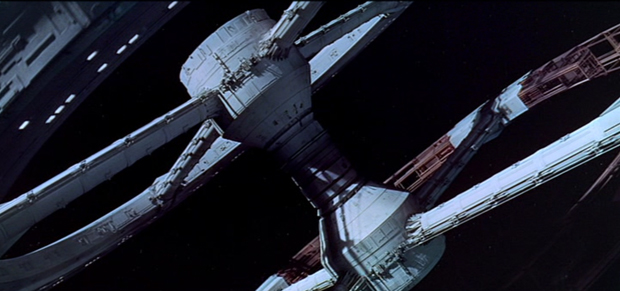
Again we have the counter-clockwise spin.
It's startling how in so many respects 2001 has managed to age so well. The choice of color palette helps, such as the muted beiges and grays in the cabin of the shuttle, the choice of materials and the clean design of the molded plastics, the illumination, the seating. Curiously, wherever we do see video, such as on the screen before Heywood, the low resolution of the images and the style of shooting injects that area with a 1967 flavor, which wouldn't have been a problem however if Kubrick had chosen to have Heywood watching an old film for we would expect resolution and shooting style in accordance with the older era.
SEE YOU ON THE WAY BACK -- MEETING WITH THE RUSSIANS
126 Elevator door of SS5 revolving open on Heywood and an attendant dressed in pink. (25:27)
I may as well note the spin is counter-clockwise, but it is impossible to tell this until the door opens.
BLOND FLIGHT ATTENDANT (unbuckling): Here you are, sir. Main level, please.
FLOYD (standing): Right. See you on the way back.
BLOND FLIGHT ATTENDANT: Bye.
FLOYD (exiting into the reception area, greeting a receptionist): Hi.
RECEPTIONIST: Good morning, sir.
FLOYD: Good morning.
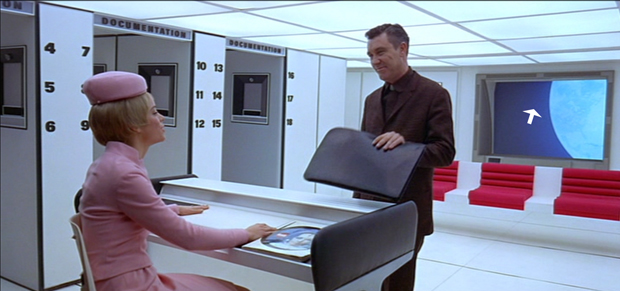
The spin of the earth outside is clockwise, which means that the rotation of the space station, as we face the landing pad side, is counter-clockwise.
RECEPTIONIST: We haven't seen you up here for a long time.
FLOYD: No. Very nice to see you again. (Checks watch.)
RECEPTIONIST: Did you have a pleasant flight, sir?
FLOYD: Very nice, thanks. I think Mr. Miller of, uh, Station Security is supposed to be meeting me.
RECEPTIONIST: Oh, well, may I call him for you?
FLOYD: Would you please? Oh, here he is.
127 Side view of Miller approaching Heywood. (26:06))
MILLER (entering): Oh, hello, Dr. Floyd.
FLOYD (shaking hands): Oh, well, how are you?
MILLER: Sorry I'm late.
FLOYD: That's quite all right. Gee, you're looking great.
MILLER: Thank you. It's nice to have you back. Did you have a good flight?
FLOYD: Very nice, indeed.
MILLER: Good. Well, shall we go through?
FLOYD: Okay.
RECEPTIONIST: Please use number 17.
MILLER: Thank you, Miss Turner.
FLOYD: Thank you, bye.
I've been talking a lot about revolutions, directions of spin, and it's of note that our receptionist here is named Turner and is seated before a map of the two wheels of the space station.
128 CU of Ms. Turner's hands pressing a button marked ENGLISH. Other language choices are Dutch, Russian, French, Italian, Japanese. (26:29)
129 Medium close-up of Heywood and Miller before the voice print ID console. (26:22)
Ms. Turner has instructed them to use #17. One may notice that the only screen that seems to have the red bar at the bottom is this screen.
VOICE ID WOMAN: Welcome to voice print identification. When you see the red light go on, would you please state in the following order your destination, your nationality, and your full name, surname first, christian name and initial.
The woman is replaced by a blue screen with instructions. The red light at the bottom comes on.
FLOYD: Moon, American, Floyd, Heywood, R.
The voice print identification woman reappears.
VOICE ID WOMAN: Thank you. You are cleared through voice print identification.
The woman is replaced by the blue screen that reads THANK YOU.
FLOYD: Thank you.
Shot 128 | Shot 129 |
 |  |
Heywood and Miller appear to exit to the rear.
130 Long shot of hallway with red seating showing HILTON reception area. (26:53)
Heywood and Miller enter from the rear speaking of breakfast, so we realize we have another "sunrise" section here, as with The Dawn of Man. For the Russians, we have instead the equivalent of sunset as they aren't having breakfast, instead they will be having drinks, alcohol, as if it is the end of their day and they are winding down. So their schedule is in reverse orientation to Heywood's.
FLOYD: I've got time for breakfast?
MILLER: Oh, I think we can manage that.
FLOYD: How long have I got?
MILLER: Your flight leaves in an hour and ten minutes. As a matter of fact I've reserved a table for you...
WOMAN'S VOICE OVER: A blue ladie's cashmere sweater has been found in the restaurant and can be claimed at the manager's desk.
MILLER: ...in the Earth Light rooms.
FLOYD: Oh, fine, thanks.
MILLER: It's been about seven or eight months since you were here last, wasn't it?
The woman's voice-over has partly obscured the conversation and now ends but is repeated.
FLOYD: Oh, well let's see, last June. About eight months.
Kubrick chooses to let us know it's February.
MILLER: Hmmm.
WOMAN'S VOICE OVER: A blue lady's cashmere sweater has been found in the restaurant and can be claimed at the manager's desk.
MILLER: I suppose you saw the work on the new section when you came in.
FLOYD: Hey, it's coming along great.
MILLER: Yeah, it's fine.
FLOYD: Oh, wait a minute. I've gotta make a couple of phone calls. You go on ahead to the restaurant and I'll meet you there.
MILLER: Right.
131 MCU of Heywood in the telephone booth. (27:37)
He removes a card from his wallet and inserts it in a slot. On the screen appears the words READY TO PLACE CALL. He punches in a number.
WOMAN'S VOICE OVER: Will Mr. Traverse please contact the met office. Will Mr. Traverse please contact the met office.
Heywood replaces the card in his wallet, and his wallet in his inner right breast pocket. A little girl appears on the video screen.
GIRL: Yes.
FLOYD: Hello!
132 CU of the girl on the video screen. (27:59)
GIRL: Hello.
FLOYD: How are you, squirt?
GIRL: All right.
FLOYD: What are you doing?
GIRL: Playing.
FLOYD: Where's mummy?
GIRL: Gone to shopping.
FLOYD: Well, who's taking care of ya?
GIRL: Rachel.
FLOYD: May I speak to Rachel, please?
GIRL: She's gone to the bathroom.
133 Shot of Heywood in the phone booth, as in shot 131. (28:16)
GIRL: Are you coming to my party tomorrow?
FLOYD: I'm sorry, sweetheart, but I can't.
GIRL: Why not?
FLOYD: Well, you know, daddy's traveling. Very sorry about it but I just can't.
134 CU of the girl on the video screen. (28:26)
GIRL: Oh.
FLOYD: I'm going to send you a very nice present, though.
GIRL: All right.
FLOYD: Anything special that you want?
GIRL: Yes.
FLOYD: What?
GIRL: A telephone.
135 Shot of Heywood in the phone book, as in shot 131 and 133. (28:40)
FLOYD: We've got lots of telephones already. Can't you think of anything else you want for your birthday? Something very special?
GIRL: Yes.
FLOYD: What?
GIRL: A bushbaby.
FLOYD: A bushbaby. Well, we'll have to see about that. Listen, sweetheart, I want you to tell mommy something for me, will you remember?
GIRL: Yes.
FLOYD: Well, tell mommy that I telephoned, okay?
GIRL: Yes.
FLOYD: That I'll try to telephone again tomorrow. Now, will you tell her that?
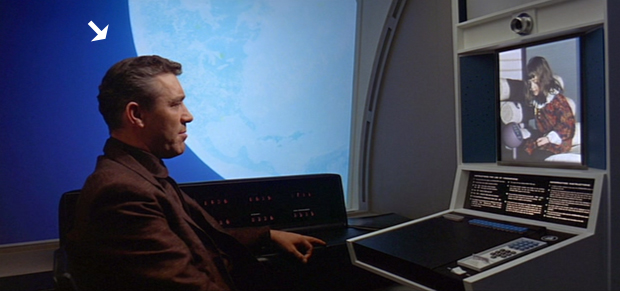
The spin of the earth out the window is now counter-clockwise. It had been clockwise out the window when Heywood met Miller in shot 126. As the earth is revolving counter-clockwie, the side of the space station facing it is once again revolving clockwise, as it was doing when we first saw the space station in shots 110 and 118. Kubrick only shows this now in the telephone booth with the conversation between the father and child, as when Miller and Heywood were walking down the hall we weren't afforded an exterior view of the earth.
GIRL: Yes.
FLOYD: Okay, sweetheart. Now, have a nice birthday tomorrow.
GIRL: All right.
FLOYD: And have a nice birthday party tomorrow...
136 CU of the girl on the video screen. (29:15)
FLOYD: ...too, uh?
GIRL: All right.
FLOYD: Okay, now, take care and be a good girl, now, won't ya?
GIRL: All right. Bye bye!
FLOYD: Bye bye! Happy birthday!
The girl on the screen is replaced with CHARGE $1.70 THANK YOU.
Heywood had been asked to use the #17 documentation booth, and the charge for his phone call is $1.70.
I discuss the bushbaby in a section further below.
Shot 131 or shot phone 1 | Shot 133 or phone 3 | Shot 135 or shot 5 | |
 | 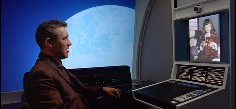 |  | |
Shot 132 or shot phone2 | Shot 134 or phone 4 | Shot 136 or shot phone 6 | |
 |  |  |
137 Long shot of the hallway near the Hilton desk and 3 woman and a man now seated about one of the white tables. (29:29)
They speak Russian, relaxing with drinks. A woman in a purple dress with a red collar appears to ask what time it is, the man checking his watch. They all look up as Heywood enters.
138 Alternate view of the hall, Heywood approaching from the phone booth. (29:36)
The three stand. Heywood approaches Elena first, calling out her name. Elena is a form of Helen, which is perhaps pertinent as the Odyssey had Odysseus attempting to return home after the Trojan War, but is prevented from doing so by Athena due her anger over Ajax' rape of Cassandra. It's said that Kubrick's initial choice for a name for the computer, HAL, was instead Athena.
Another reference to the tale of Troy may be the magazine we could barely make out on the desk of the receptionist. I read it was especially designed by "Paris Match", and from what I could tell of a photo of it, the cover appeared to depict a woman in a space helmet.
Paris was the Trojan who ran off with Helen to Troy.
The journey aspect of Odysseus is one thing, and his seafaring voyage is to be related somewhat to these spacecraft in the veritable seas of space. But Kubrick also brings up Troy in Eyes Wide Shut as per its mythological relationship to mazes (the Troy maze) and in The Shining of course the maze is a major player. It is present without the Overlook as well as within. And in Eyes Wide Shut Bill walks mazes of streets that are not just the same set but are intended to be symbolically read as fundamentally the same. In Eyes Wide Shut Bill repeats his visitations of the first part in the second part, after his trip to Somerton, just as in A Clockwork Orange Alex repeats his encounters of the first part of the film in the second part, after his Ludovico treatment. We find also in 2001 the same idea of re-enactment with Poole undergoing the same space walk as Bowman.
Enough about that for now. We will return to this later.
The character of Symslov, who is the individual here who confronts Heywood over what is happening at Clavius, is named after the chess player Vasily Smyslov. And we have a form of chess, at least a tactical discussion, between Heywood and Smyslov during which Heywood refuses to divulge any information. Later we have a chess game on Discovery One between HAL and Frank Poole.
FLOYD (shaking her hand): Elena! How nice to see you again.
ELENA: Heywood, what a wonderful surprise to meet you here.
FLOYD: You're looking wonderful.
ELENA: Thank you. You're looking well, too. This is my good friend, Dr. Heywood Floyd. I'd like you to meet Dr. Kalinan.
FLOYD (shaking the hand of the woman to Elena's left): How do you do.
KALINAN: How do you do.
ELENA: Dr. Stretyneva.
FLOYD (shaking the hand of the woman in purple): How do you do.
STRETYNEVA: How do you do.
ELENA: And this is Dr. Andre Smyslov.
FLOYD: Oh! How do you do.
SMYSLOV (shaking hands): Floyd.
FLOYD: I've heard a lot about you.
SMYSLOV: Would you sit down?
Again, as with in the phone booth, the spin of the earth out the window is counter-clockwise, which means the side of the space station facing it would be spinning clockwise if we were facing it.
139 Opposing view down the hall as in shot 137. (30:00)
Heywood looks about seeing there is no chair for him and Smyslov directs him to take his chair.
FLOYD: Well...
SMYSLOV (indicating his chair): No, no, please.
FLOYD: Well, thank you.
The women seat themselves, as does Heywood. Smyslov pulls up another chair.
SMYSLOV: Would you, would you like a drink Doctor?
FLOYD: Oh, no, thank you. As a matter of fact I haven't had breakfast yet and someone's meeting me in the restaurant. No, if you don't mind I'll just sit with you a few minutes and then I must be off.
SMYSLOV (seated, sliding his drink toward him): Are you quite sure?
FLOYD: Quite sure, thank you.
140 Slightly closer view of shot 139. (30:16)
FLOYD (to Elena): Well, how is Gregor?
ELENA: Oh, he's fine. He's been doing some underwater research in the Baltics, so I'm afraid we don't get a chance to see very much of each other these days.
FLOYD: Well, when you do see him be sure to give him my regards.
ELENA: Yes, of course.
FLOYD: Well, where are you all off to? Up or down?
ELENA: We're going home. We've just spent three months calibrating the new antennae at Tchalinko. What about you?
FLOYD: I'm just on my way up to Clavius.
SMYSLOV: Oh. Are you? Well, Dr. Floyd, I hope you don't think I'm being too inquisitive, but perhaps you can clear up the great big mystery about what has been going on up there?
FLOYD: I'm afraid I don't know what you mean.
There have been subtle background noises of activity occurring elsewhere, perhaps in the restaurant. These become slightly more obvious.
141 Medium close-up shot of the group towards the restaurant. (30:58)
The woman in purple had a blue sweater on the back of her chair in 138. It has not been in other shots but has appeared again. A tan sweater was on the back of Kalinan's chair until shot 139, when we saw it had fallen behind her chair. It has now reappeared on the back of her chair.
SMYSLOV: Well it's just that for the past two weeks some extremely odd things have been happening at Clavius.
FLOYD: Oh, really.
SMYSLOV: Yes, yes, yes. Well, for one thing whenever you phone the base all you can get is a recording which repeats that the phone lines are temporarily out of order.
FLOYD: Well, probably having some trouble with their equipment or something like that.
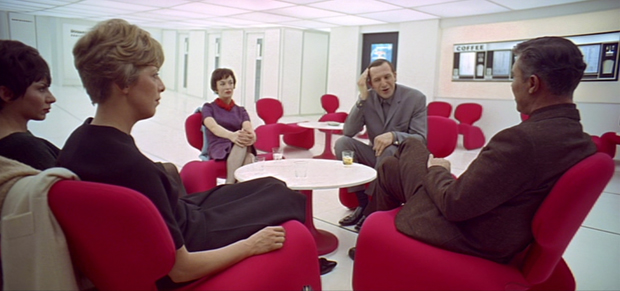
SMYSLOV (stroking his hair): Yes, yes. That's what we thought was the explanation at first but it's been going on now for the past ten days.
Smyslov, running his hand over his hair in this manner, reminds strongly of the hotel clerk in Eyes Wide Shut who is questioned by Bill about Nick Nightingale.
The gesture may be unscripted, but in both instances it has struck me as artificial and something with which neither actor was entirely certain about. Here, with Smyslov, he will soon become himself reticent to speak when one of the attendants in pink passes behind. In Eyes Wide Shut a man passes by who is dressed with Peter Seller's as the detective Clouseau in one of his Pink Panther films. Another common bond between the two scenes is the idea of the hotel, with the Hilton hotel desk on one side of the lobby and a Howard Johnson's restaurant (another motel/hotel) on the other side. It may be an in-joke reference in Eyes Wide Shut.
The hotel scene in Eyes Wide Shut certainly recalls the space station with the choice of ceiling over the hotel desk.
This is such an uncommon gesture in Kubrick's films, as is the use of a lit, tiled ceiling, that I have to think of Eyes Wide Shut as referring back to 2001 as Bill pursues information about the pianist but is put off, perhaps even given misinformation, just as Smyslov and Heywood are sparring with one another.
FLOYD: You mean you haven't been able to contact anyone for the past ten days?
SMYSLOV: That's right.
FLOYD: Oh, I see.
ELENA: And there's another thing, Heywood. Two days ago one of our rocket buses was denied permission for an emergency landing at Clavius.
FLOYD: Well, that does sound odd.
SMYSLOV: Yes, yes. I'm afraid that there's going to be a bit of a row about it. Denying the men permission to land is a direct violation of the IAS convention.
FLOYD: Yes. Of course, of course. The crew get back all right?
SMYSLOV: Yes, yes. Fortunately, they did.
FLOYD: Well, I'm glad about that.
The receptionist in pink, who had welcomed Heywood to SS5, appears from the direction of the restaurant and passes down the hall as the conversation continues. She carries what seems to be a blue file.
SMYSLOV: Dr. Floyd, at the risk of pressing you on a point, you seem reticent to discuss, may I ask you a straightforward question?
FLOYD: Well, certainly.
142 Close-up of Smyslov as the woman passes behind him. (32:06)
SMYSLOV: Well...
He pauses as the woman passes, then begins to speak again.
SMYSLOV: Quite frankly, we've had some very reliable intelligence reports that quite a serious epidemic has broken out at Clavius. Something apparently of an unknown origin. Is this in fact what has happened?
143 Shot as of 140. (32:23)
A long period of silence.
FLOYD: I'm sorry, Dr. Smyslov, but I'm really not at liberty to discuss this.
SMYSLOV: I understand. But this epidemic could quite easily spread to our base. We should be given all the facts, Doctor Floyd.
FLOYD: Yes, I know that. As I said, I'm not at liberty to discuss it.
ELENA (after an extended silence): Now, are you sure you won't change your mind about that drink?
FLOYD: No, I'm positive. (Glances at watch.) Well, I really must be going.
ELENA: Well, I hope that you and your wife can come to the IAC conference in June.
FLOYD: Well, we're gonna try. I hope we can make it.
ELENA: If you do, you remember to bring that darling little daughter with you.
FLOYD: Well, that'll all depend on the school vacations and all that sort of thing, but if we can we will. Don't forget, you've got a standing invitation if you ever get to the states.
ELENA: Of course not. Gregor and I will look forward to seeing you.
FLOYD: Okay.
144 Return to the shot as in 138 (33:21)
FLOYD (standing): Well, goodbye Elena.
Smyslov and Elena stand. Elena and Heywood shake hands.
FLOYD: It's been a pleasure meeting you all. Dr. Smyslov.
SMYSLOV (shaking hands): Well, whatever the reasons for your visit to Clavius, Dr. Floyd, the very best of luck to you.
FLOYD: Well, thank you. Ladies.
Heywood nods at the two seated women and walks off screen left in the direction of the restaurant. Smyslov and Elena take their seats again, speaking Russian. Fade to black.
Below are shots 137 to 144 showing a discreet round trip of sorts. Intro are shots 137 and 138 showing oppositonal views. Shot 139 repeats 137. Rather than having another opposing view, Kubrick comes in for a slightly closer shot, then he shows another vantage point in shot 141 and focuses in on Smyslov in shot 142 when a receptionist is passing, and he quiets, fearing being overheard. Shot 143 repeats shot 140 and then Kubrick takes out with 144 repeating shot 144.
Smyslov fearing the receptionist will hear him brings to mind HAL later lip reading Dave and Frank in the pod.
The red chairs appear to be just a wonderful design choice, but they serve a thematic purpose as well. They are very distinctive and their red color pops against the white. When we view the repeating lines of them in so many shots below we are in a sense being given repetitions into infinity, opposite also 3 screens.
Shot 137 or shot 1 | Shot 139 or shot 3 | ||
 |  | ||
Shot 138 or shot 2 | Shot 144 or shot 8 | ||
 | 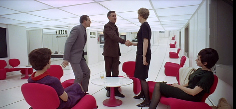 | ||
Shot 140 or 4 | Shot 143 or shot phone 7 | ||
 |  | ||
Shot 141 or shot 5 | |||
 | |||
Shot 142 or shot 6 | |||
 |
Clearly, Kubrick having Smyslov named after a chess player, we have to later look for a relationship between this scene and the chess game with HAL. HAL, aligned in the film with Heywood, will be the only intelligence on the ship aware of the truth of its mission, just as Heywood here has knowledge about Clavius he isn't sharing with the Russians, which he later explains as being necessary against cultural shock and social disorientation.
As for the aesthetics of the scene, its spotlessly gorgeous with its reds against the luminescent whites, these blended in the pink uniforms of the female employees. We even have pale pink luminescence in some scenes in the ceiling above such as in shots 140 thru 144, framed with a vignette of cooler tones.
THE MOVING DJINN CHAIRS
The chairs for this scene, designed by Olivier Mourgue, were called Djinn chairs. First, we have been, earlier, listening to a Requiem Mass, and even with Olivier's last name, Mourgue, we have a suggestion of death. As for the chairs themselves, Mourgue's site states, "Olivier Mourgue named the chairs 'Djinn" which In Muslim legend, a spirit often capable of assuming human or animal form and exercising supernatural influence over people." Wikipedia instead simply states that the chairs are named for the Djinn, a spirit capable of changing shape. It needs to be considered that Heywood exits to find the group of Russians sitting on the Djinn chairs, waiting for him, and that now we have Dave in this semblance of a hotel room that is based in part on the Space Station. I'm not suggesting the Russians aren't real, that they're instead djinns, but metamorphosis is a property of all Kubrick's films.
These chairs move.
Before the telephone booth scene, we see that the Djinn sofas are positioned between or to the side of the windows. When Heywood steps out of the phone booth, the Djinn sofa on which the Russians are seated is positioned before the window. They haven't simply moved it for we see that the other Djinn chairs further down the hall retain regularity in spacing and that a couple of others have been positioned now before the windows.
THE BUSHBABY
With the request for a bushbaby the child is asking for a primate that is a night animal, whereas the hominids shown in The Dawn of Man section were fearful of the night before their introduction to the Monolith and new technology that made them capable of defending themselves. From now on the film there is no "day" as defined by sunlight. Everything outside the windows is black. Day or night is relatively meaningless, ruled by artificial light and schedule. In a sense, humans now live in eternal night, bereft of sun.
A bushbaby is a form of lemur, named for the ghostly lemuria, phantoms considered malicious by the Romans. They were also considered ancestral gods, spirits of the underworld that were restless, who had not been buried appropriately. They could be appeased with beans on a particular night of the year, and in this way resemble the idea of spirits congregating on Halloween, appeased with gifts, and also the remembrance of relatives and ancestors on the Day of the Dead, before All Saints Day.
We might want to keep this in mind with Frank Poole, whose body Dave attempts to salvage and bring back to the ship, but which he must release to the void in order to save himself. The other individual who happens to celebrate a birthday in this film is Frank Poole.
THE ETERNAL RETURN WALTZ (AGAIN) AND ARIES VISTAS
145 Fade from black to the Aries Ib shuttle making its way to the moon. (33:48)
The Blue Danube Waltz begins again.
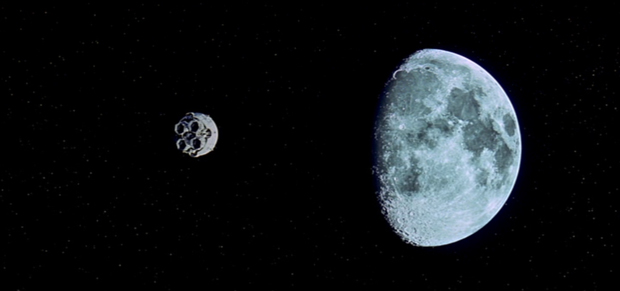
146 Passenger area of the Aries Ib. A Pan Am flight attendant carries trays away from an elevator. (34:01)
The camera turns to follow her and we see Heywood sacked out in a seat, sound asleep, covered with a blanket. As he's asleep she doesn't leave a food tray with him. The camera follows her as she makes her way over to another flight attendant who is watching a karate match on a flat screen. She takes one of the trays and both glance over to Heywood, who is off screen, as if discussing him. The flight attendant leaves with her other tray. I discuss this further below.
147 CU of the flight attendant extending the straws on the food tray. (34:37)
Food is removed a number of steps from its natural state and communicated with artistic graphics, the graphics serving a practical purpose perhaps as well so that one need not be dependant on English. We see an unknown food upper left, an orange and strawberry, a wedge of cheese, coffee represented by a cup with beans pouring into it, a smiling green fish covered with orange dots, two ears of corn, a pea pod and two carrots.
148 The Aries IB this time viewed with the Sun and Earth in the background. Whereas we'd seen the rear of the shuttle before, we now see the red of the cockpit. The red glow around the white sun anticipates also HAL's red light. (34:41)
149 The flight attendant section with a view of the elevator. (34:50)
The elevator door slides to the side and the attendant exits. She gets another tray from the food console then steps into a circular chamber and walks 180 degrees up the wall.
She exits into the cockpit.
150 View of a door in a red room. The door slides open to the side and we see the flight attendant, now upside down, entering the cockpit. (35:49)
The camera view which was turned 180 degrees from shot 149, now revolves 180 degrees as the attendant delivers the food to the pilots. This is a little confusing as, returning to shot 149, the way the attendant exits the elevator into the flight attendant area suggests that her orientation to the craft is the same as the passenger area, and she revolves 180 degrees to enter into the pilot area when it seems she should have revolved about 90 degrees and exited through the portal foremost to the camera.
151 MCU from behind the flight attendant as the pilots take their trays, giving us a view of the controls. (36:01)
We see the moon out the window in half shadow. Speaking with the pilots, the woman leans against the seat of the pilot on the right.
152 Exterior view of the AriesIB showing the cockpit. (36:06)
153 Medium shot of Heywood dining, drinking through one of the straws. (36:16)
The elevator door behind him opens to the side and a pilot exits. He steps over to speak to Heywood, who has thoughtlessly let go his tray. The pilot points out to him it is floating away and Heywood grabs it.
154 The famous scene of Heywood reading the instructions for the Zero Gravity Toilet. (36:38)
155 The rear of the AriesIB with the moon beyond. (36:49)
156 Another view of the AriesIB approaching the moon. (37:02)
157 3/4 Medium long shot from behind Heywood as he watches the moon, it filling all the windows (37:18)
158 Closer shot of the propulsion engine (?) side of the AriesIB as it maneuvers for landing, the legs extending. (37:27)
Shot 152 | Shot 153 |
 |  |
Shot 154 | Shot 155 |
 |  |
Shot 156 | Shot 157 |
 |  |
Shot 158 | |
 | |
159 Alternate view from the top showing the red windows of the cockpit. (37:52)
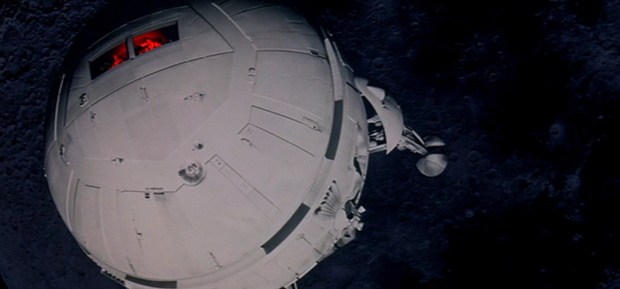
Kubrick gives us an even clearer view of the pilots at the "top" of the craft, their orientation about a 90 degree turn from the passenger area rather than a 180 degree turn.
160 Side view of the AriesIB continuing its descent, the distant earth coming into view and then the moon beneath it. Kubrick has the same yellowish tint on the edges of the scene as had earlier with the earth. (38:03)
161 Interior of the cockpit, 3/4 medium shot view of the pilots and flight attendant, now seated, from the front. (38:23)
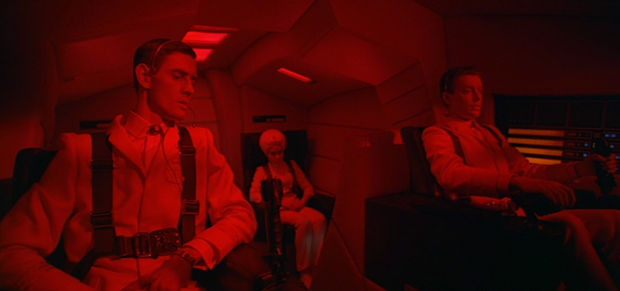
162 The pilots from rear and above. (38:28)
Just as the pilots of the earlier shuttle looked almost identical from the rear, Kubrick stages the same with these pilots. The earlier pilots had darker and slightly curlier hair and were nearly mirror images of one another. Here, again, Kubrick has pilots who share the same color and texture of hair and physique.
It is actually impossible for the pilots to have this view of the base they are approaching, for their red lit windows, at the "top" of the craft, don't afford this perspective.
163 3 astronauts on moon hill with the base below and the Earth in half shadow beyond. (38:50)
The AriesIB descends into view. It may be that the individual on screen left is the photographer we will momentarily view at Heywood's meeting.
164 View from inside the 8 lobes of the landing base opening to receive the AriesIB. (39:07)
Shot 163 | Shot 164 |
 |  |
165 Exterior view of the 8 lobes of the landing base opening to reveal the lit square the landing pad inside. (39:21)
166 Interior of cockpit from behind the pilots as of shot 151. (39:42)
This time Earth is viewed out the window whereas in shot 151 the moon was viewed.
Again, it is impossible for the pilots to have this perspective of earth as their cockpit is positioned so it looks out the "top" of the craft rather than the side, and Kubrick ensures that we're aware of just where the cockpit is with the use of the red light, and having shown us Heywood in the passenger area looking out upon the moon through one of the side windows.
Which is remarkable. Kubrick has spent mega-bucks and vast amounts of creativity and energy in research to have 2001 appear as realistic as possible in its visionary future. And yet...and yet...he then depicts the pilots seeing earth and the moon base when they are clearly not in a position to view them. He contrives this wonderful process in which we see the flight attendant maneuver to the pilot's deck in zero gravity, and yet she is seemingly 90 degrees off when she steps into the flight deck. Instead of having turned 180 degrees she should have turned only 90.
All of this was wonderful eye-tech candy for the viewer of the time, and continues to be incredible design eye candy, but there is more going on here than entertaining the audience with visions of future space travel that communicated to the everyday person as real and weren't just a few guys and a gal in a metal Hollywood can traveling to the moon or Mars to battle space vampires. Primed by Tang and the moon missions, back in 1958 you were going to be truly agog and marvelling at the next step in Boy Voyages and weren't going to pay much attention to any peculiarities in Kubrick's representation. Maybe the more astute would notice that the pilots shouldn't have been able to view earth, but this fact would be invisible to most of the people in their theater seats, even with Kubrick clearly showing multiple times that the views out the flight deck were impossible, just as people can watch The Shining multiple times and never begin to grasp that only one interior window of the hotel has any seeming relation at all to both the stage and real exterior of the Overlook hotel, and that everything else we observe of the interior has no relationship to the exterior. The maze literally changes orientation in relationship to the hotel, its entrance moving about 90 degrees, and this is so observable as to be a bright red flag signalling, "Hey! Look! Look!"
We've already examined how Kubrick has reverse orientations he inserts. We saw this with the Monolith and the landscape behind it and the reversals in spins of the Space Station. Now we are seeing the 90 degree turns that Kubrick will discreetly insert in scenes.
These 90 degree shifts happen repeatedly and we need to consider them seriously. In The Shining, in the heart of the maze, Danny made a reversal, reversing his tracks, then jumped to the side at a 90 degree angle in a bid for survival, thus disappearing at the maze's heart and Jack passing by him.
The first stage of the voyage, in the Orion, we had the mirror images of the pilots and the focus on clockwise and counter-clockwise orientations.
The second stage of the voyage, in the Aries, the pilots look a little less alike (though very strongly resembling each other from the rear and bathed in these red lights) and we have instead this focus on 90 degree shifts. The flight attendant turns 180 degrees (upside down) yet the flight deck that she enters, where she is bathed in red, is at a 90 degree angle from the passenger part of the ship, and (yet again) those on the flight deck are viewing everything as if they instead have the same orientation of the passengers.
Their seeming orientation to the target has seemed to be moving in a clock-wise position and appears to line up when Kubrick cuts away.
167 A close-up of the landing "target" almost but not quite locked in, but this time the movement is from a counter-clockwise position at it locks. (39:55)
Again we have the reverse in orientation, even as we move in for the close-up. Instead of clockwise we now have counter-clockwise and it shifts back a little in time. Kubrick will repeat this a couple of other times in the film, most notably with shot 294.
168 The touchdown of the AriesIB. (40:00)
The lower shot above is slightly adjusted to be less dark, for though I know I should ignore the lens flares at the top of the screen, I'm not going to do so. For one thing, Kubrick, with his seeming brushstrokes subtly appearing over the sky in the Dawn of Man sections has led me to pay attention to what's going on in the background. And also because we were just shown the "target" area very clearly, the cross within a series of ellipses of decreasing circumference (shot 167). Within the craft, as the craft lined up, we viewed them from within the circles. Now, it seems almost as if, with these lens flares, we are viewing the same from without, and center over the Aries is a lens flare that is a close approximation of the "target" image with a cross within an ellipses that is part of a spiral helix.
We will have one more target emphasis in this section and then not another until later in the story which will mandate additional commentary on their significance.
169 The landing platform, carrying the craft, descends into the base. (40:13)
We are granted a second view of the craft descending on a screen within a viewing theater to the left.
The Aries, as it descends, is easily anthropomorphized so that it appears to bear facial features: eyes, a nose, a mouth. This anthropomorphizing of space craft will be apparent in later sections, but is first observed here.
KARATE AND THE OPEN HAND
A flight attendant brings Heywood his lunch/dinner but he is asleep. She instead goes to sit next to another attendant who is watching a karate match.
What the karate video does is possibly communicate that the aggression, as in the Dawn of Mind section, has been refined to be an art form. Karate means "empty hand" and as a form of fighting without a weapon would seem to take us back to a time before the appearance of the Monolith, when primates had no weapons, but I instead think Kubrick could possibly be considering the advancement of intellect to being able to do battle without any weapons at all, for Dave Bowman overcomes HAL without the use of weaponry.
Empty Hand is certainly being referred to as the last time we saw Heywood asleep, another flight attendant had also come over to him.
But Kubrick may have a meaning here tied to the hand in Hebrew, either the Yod or Kaph. Some give Yod as an open hand and that Kaph is a fist while others say Yod is the fist and Kaph is the open hand. Either way, Yod also represents a dot, a divine point, and is stated to be the building block of creation upon which all the other letters of the alphabet (and the whole of creation) are built. Interpreting Kubrick's use of the open hand in this manner would make sense as above it rested a pen, which forms letters, in the earlier scene in which he was asleep.

His empty hand had been floating in space as she took the floating pen and placed it in his pocket. Kubrick is definitely drawing an association between these scenes and the idea of Empty Hand.
GRAVE POTENTIAL FOR CULTURAL SHOCK AND SOCIAL DISORIENTATION
First a couple of notes on the conference space. It looks like at the top there are cameras set at regular intervals within the wall above the lights? The room, indeed, resembles a photographer's lightbox.
The table is set for 15 attendees but there are only 12, including Halvorsen, Heywood and Bill at the head of the table. We will find, as we go along, that Kubrick has embedded something down the line of a Last Supper theme to go along with the Communion music of the Requiem Mass which is played in this section later. Here we begin to lead into that with 12 attendees. But of course the Last Supper was composed of 13, the 12 disciples and Christ. Here we have 13 if we count the photographer, though he leaves the room.
The photographer is something of an enigma as we shall later see.
170 Rear view of Heywood in a Clavius conference room with a photographer taking pictures. (41:06)
PHOTOGRAPHER: Excuse me, Dr. Halvorsen. I'm through now. Thank you very much, gentlemen.
DR. HALVORSEN: You're welcome.
Halvorsen rises and goes to the podium at the front of the room.
DR. HALVORSEN: Well, I know you will all want to join with me in welcoming our distinguished friend and colleague from the National Council of Astronautics, Dr. Heywood Floyd. Now, Dr. Floyd has come up especially to Clavius to be with us today. And before the briefing I know he would like to have a few words with you. Dr. Floyd?
Polite applause as Floyd rises to walk clockwise to the podium and Halvorsen walks clockwise returning to his seat. Their movements are paced to be equivalent each other.
FLOYD: Well, thank you, Dr. Halvorsen. Hi, everybody. Nice to be back with you. Well, first of all, I bring a personal message from Dr. Howell, who's asked me to convey his deepest appreciation to all of you, for the many sacrifices you've had to make. And, of course, his congratulations on your discovery, which may well prove to be among the most significant in the history of science.
171 Med close-up of Heywood from the side. (42:52)
FLOYD: Now, I know there have been some conflicting views held by some of you regarding the need for complete security in this matter. and more specifically your opposition to the cover story created to give the impression there is an epidemic at the Base.
172 Med long shot from behind Floyd showing an alterate view of the room. (43:11)
HEYWOOD: I understand that beyond it being a matter of principle, many of you are troubled by the concern and anxiety this story of an epidemic might cause to your relatives and friends on Earth. Well, I can...
173 Long shot of Floyd from behind the individual who was seated at his right.(43:27)
FLOYD: ...completely sympathize with your negative views. I found this cover story personally embarrassing myself. However, I accept the need for absolute secrecy in this and I hope you will, too. Now, I'm sure...
174 3/4 med shot of Heywood showing no one else. (43:46)
FLOYD: ...you're all aware of the extremely grave potential for cultural shock and social disorientation contained in this present situation if the facts were prematurely and suddenly made public without adequate preparation and conditioning. Anyway, this is the...
175 Return to shot as originally had in 170 from behind Heywood's chair. (44:02)
FLOYD: ...view of the Council. The purpose of my visit here
is to gather additional facts and
opinions on the situation and to
prepare a report to the Council
recommending when and how the
news should eventually be
announced.
176 Shot as in 171 of Heywood from the side. (44:21)
Now, if any of you would like to give me your views and opinions, in private if you like, I'd be only to happy to include them in my report.
177 As in shot 172, from behind Heywood, showing the others in the room. (44:31)
FLOYD: Well, I think that's about it. Any questions?
178 Med long shot of Bill from the front, he being the one who was seated to the right of Heywood. (44:39)
BILL:
Dr. Floyd, have you any idea how much longer this cover story will have to be maintained?
179 Shot as 173 from behind Bill. (44:44)
FLOYD (laughs): I don't know, Bill. I suppose it will be maintained as long as deemed necessary by
the Council. And of course there must be adequate time for a full study of the situation before any thought can be given to making a public announcement. Oh, yes...
180 Shot as in 176 and 171 of Heywood from the side. (45:00)
FLOYD: ...as some of you already know, the Council has requested
that formal security oaths are to
be obtained in writing from every-
one who had any knowledge of this
event. Well, were there any more questions?
181 Return to the shot as originally from behind Heywood's chair with a full view of everyone and the podium. (45:12)
HALVORSEN (rising): Well, I'm sure we'll all want to cooperate with Dr. Floyd as fully as possible. And, as there seems to be no more questions, I think we ought to get on with the briefing. Thank you, Dr. Floyd.
FLOYD (leaving the podium): Thank you.
Heywood comes counter-clockwise around the room as everyone softly claps and Bill stands, nudging Heywood's chair out of the way, in order to go to the podium.
Let's look again at the structure of this section.
Shot 170
Shot 171
Shot 172 (an opposing shot of 170, the opening shot)
Shot 173
Shot 174
Shot 175 repeats 170
Shot 176 repeats 171
Shot 177 repeats shot 172
Shot 178 is a shot of Bill which will not be repeated
Shot 179 repeats shot 173
Shot 180 repeats 171/176
Shot 181 repeats shot 170, returning to it and closing the circle.
Another way of looking at it in 3 sections.
Shot 170 or shot conf 1 | Shot 175 or conf 6 | Shot 181 or shot conf 12 | |
 |  | 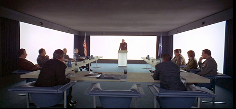 | |
Shot 171 or shot conf 2 | Shot 176 or conf 7 | Shot 180 or shot conf 11 | |
 |  | 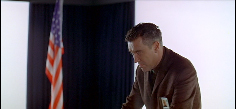 | |
Shot 172 or shot conf 3 | Shot 177 or conf 8 | ||
 |  | ||
Shot 173 or shot conf 4 | Shot 179 or shot conf 10 | ||
 |  | ||
Shot 174 or shot conf 5 | Shot 178 or shot conf 9 | ||
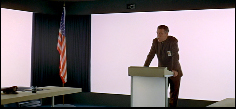 |  |
Kubrick begins repeating at shot 6, after shot 5 of Heywood which will not be repeated. Shot 5 of Heywood is not repeated and in this way corresponds to shot 9, of Bill, which is also not repeated. One could say it is here or with shot 10 that Kubrick turns around (in a sense) and begins cycling back with shot 10 echoing shot 4, then shot 11 echoing shot 2 and shot 12 echoing shot 1.
ISOLATION
We have progressing degrees of isolation here, as we have isolation, being cut off from society, in many of Kubrick's films. In Lolita, Humbert and Lolita were, in effect, cut off from society during their road trip. In The Shining, the Torrances become cut off from society at The Overlook. In 2001 the moon base has been cut off from society, for which Heywood is apologizing, and later Poole and Bowman are threatened with being cut off from communicating from earth. All of this has to do with CRM-114 as represented in Dr. Strangelove.
COMMUNION
182 Long shot through a moon valley of the moonbus transporting Floyd from Clavius to the TMA-1 post in the crater Tycho. (45:36)
A strong hum as the craft zooms in and passes "overhead" as if coming from the craft itself.
183 Side and opposing view of the craft as it continues on. (45:41)
184 Front view of the craft, the windshields of its red-lit cockpit. (45:50
Spectral voices enter into the hum. It is Ligeti's "Lux Aeterna" (eternal light), also the communion antiphon for the requiem mass. Ligeti's Kyrie Eleison from his Requiem Mass had played during the Dawn of Man section as the sun rose upon the sleeping hominids, as they awoke and viewed the monolith.
May everlasting light shine upon them, O Lord,
with your Saints forever,
for you are kind.
Grant them eternal rest, O Lord,
and may everlasting light shine upon them.
with your Saints forever,
for you are merciful.
If you're at all familiar with the communion, you'll know it's conceived to be the transubstantiation of wine and bread into the real blood and body of Christ, in remembrance of Christ. "Do this in remembrance (anamnesis) of me." Anamnesis can be understood as not just a memorial but as making present the past, and thus does one enter the "Paschal Mystery" (Passover, passing over). I have written elsewhere of Kubrick's use of this in his other films. Please refer to this post dealing with Kubrick's use of railroad imagery in conjunction with anamnesis ideas and also Remembrance and Repetition in Kubrick's "The Shining".
185 Interior of red-lit cock-pit, looking out over the rocky moon from behind and above the two pilots. (46:04)
The pilots in the first shuttle had been so near alike they could have been a mirror image of one another at times. The pilots in the second shuttle were also very much alike but not as much. Kubrick has broken with this now and the pilots are entirely different in appearance.
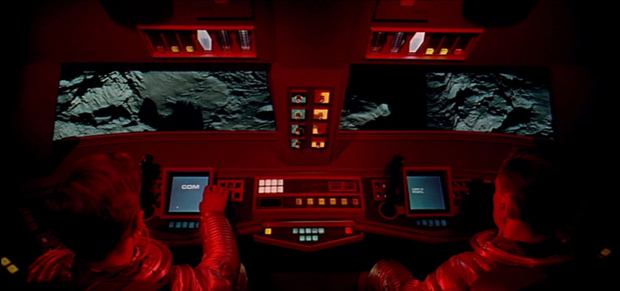
186 The earth as seen through a moon valley. (46:13).
The camera pulls up from its view on the earth to the sky as the moonbus zips by, left to right.
187 Long long shot again of the moonbus over the lunar landscape, traversing right to left. (46:24)
It briefly vanishes behind a pillar of moon rock.
188 Medium-long shot of the moonbus from the side, the earth beyond. (46:33)
This time we are able to see the blue-lit windows of the passenger area and people within.
The moonbus is still moving left to right as it was in shot 186. However, note that the moon appears to have flipped orientation horizontally here. At least its right is now in shadow whereas in shot 186 its left had been in shadow.
189 Lunar landscape. The moonbus enters from the left, moving to the right. 46:40
190 Interior of the moonbus, from behind the pilots, further removed from them in shot 185. (46:48)
The music continuing, the camera zooms out from the view of the cock-pit and into the passenger area. Bill is unlashing some rope from a container which he lifts and carries back to Heywood and Halvorsen. The music has faded out.
Shot 182 | Shot 183 |
 |  |
Shot 184 | Shot 185 |
 |  |
Shot 186 | Shot 187 |
 |  |
Shot 188 | Shot 189 |
 |  |
Shot 190 | |
 | |
191 Medium shot from behind Heywood and Halvorsen, Bill approaching with the container. (47:07)
BILL: Well, anybody hungry?
FLOYD: What have we got?
BILL (taking off the lid): You name it.
FLOYD (taking out a sandwich): What's that, chicken?
BILL: Something like that. Tastes the same, anyway.
HALVORSEN: Any ham?
BILL: Ham, ham, ham, ham. There.
HALVORSEN (taking the sandwich): There.
FLOYD: They're pretty good.
BILL: Oh, they're getting better at it all the time.
The dialogue even refers to the idea of anamnesis, but here as something being like and becoming better all the time. At least it tastes the same. The anamnesis is significant as we are about to have another encounter with the monolith.
HALVORSEN: You know that was an excellent speech you gave us, Heywood.
BILL: It certainly was.
HALVORSEN: I'm sure it beefed up morale a hell of lot.
192 Medium shot of Heywood from behind Halvorsen's chair, he eating. (47:44)
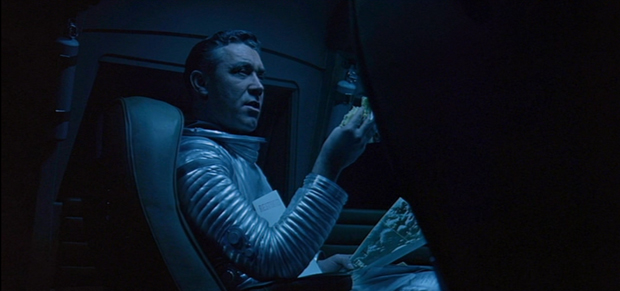
FLOYD: By the way, I wanted to say to both of you that I think you've done a wonderful job, and I appreciate the way you've handled this thing.
194 Return to shot as of 191, from behind Heywood and Halvorsen. (47:50)
Bill steps away to the front of the moonbus.
HALVORSEN: The way we look at it, it's our job do this thing the way you want it done. We're only too happy to be able to oblige.
BILL (returning with images he takes out of plastic): You seen these yet?
FLOYD: Let me have a look at them.
BILL: Here's what started the whole thing.
FLOYD: Oh, yeah.
194 Close-up of Heywood holding an image of the crater. (48:05)
HALVORSEN: When we first found it we thought it might be an outcrop of magnetic rock.
HALVORSEN: But all the geological evidence was against it. Not even a big nickle-iron meteorite could produce a field as intense as this.
HALVORSEN: So, we decided to have a look.
BILL: We thought it might be the upper part of some buried structure so we excavated out on all sides but unfortunately we didn't find anything else.
195 Return to as shot 194, from behind Heywood and Halvorsen. (48:25)
HALVORSEN: What's more, the evidence seems pretty conclusive that it hasn't been covered up by natural erosion or other causes. It seems to have been deliberately buried there.
196 Side view of Heywood from behind Halvorsen's chair, as with shot 192. (48:35)
FLOYD (laughing): Deliberately buried.
197 Return to as shot 195, from behind Heywood and Halvorsen. (48:40)
BILL: Well, how about a little coffee.
Heywood and Halvorsen say great, good idea. Bill walks up front to get the container. Heywood says something about wishing they had any idea "what the damn thing is".
HALVORSEN: I wish the hell we did. Nope, the only thing we're sure of is it was buried four million years ago.
Bill, returning, hands out cups and pours the coffee.
FLOYD: Well, I must say you guys have certainly come up with something.
BILL: Watch out now, it's hot.
TMA appears to stand for Tycho Magnetic Anomaly. Magnetic comes from the word "magnesia" which, in alchemy was the "main ingredient of the philosopher's stone". Etymology online states the same word was also used for a "mineral commonly used in bleaching glass" which was the modern pyrolusite, which would be of no interest perhaps except that pyro means "by heat, by fire" and Bill has just told Bill to "Watch out now, it's hot".
BAELUS says: I bid you take Mercury, which is the Magnesia of the Moon, and subject it and its body to coction till it becomes soft, thin and like flowing water. Heat it again till all its moisture is coagulated, and it becomes a Stone.
But there are many descriptions of the stone.
Know that this matter I call the Stone; but it is also named the feminine of magnesia, or the hen, or the white spittle, or the volatile milk, the incombustible ash, in order that it may be hidden from the inept and ignorant, who are deficient in goodness and self-control; which I have nevertheless signified to the wise by one only epithet, viz., the Philosopher's Stone. Include, therefore, and conserve in that sea, the fire, and the heavenly Flyer, to the latest moment of his exit. But I adjure you all, Sons of philosophy, by our Benefactor who gives to you the ornament of His grace, that to no fatuous, ignorant, or inept person ye open this Stone.
Shot 191 or shot 1 | Shot 197 or shot 7 | |
 |  | |
Shot 192 or shot 2 | Shot 196 or shot 6 | |
 |  | |
Shot 194 or shot 3 | Shot 195 or 5 | |
 |  | |
Shot 194 or shot 4 | ||
 | ||
Looking at the above shots we see the organization for them. Kubrick leads in with 191 thru 194. We have the shot in which we are shown several stills of the crater. This shot will not be repeated. After this, Kubrick turns about and leads us out again by having shot 195 reduplicating shot 194, shot 196 reduplicating shot 192, and shot 197 reduplicating shot 191.
198 Lunar landscape over which the moonbus passes right to left. (49:07)
The music begins again.
199 Exterior of the moonbus, showing the red-lit cockpit and activity within. (49:16)
We are clearly shown the pilot who was on our left, in interior shots of the cockpit, returning to take his seat, which is empty, the pilot on the right still seated. A person stands behind, who appears to be Bill.
200 Lunar landscape, the moonbus passing from lower right to left. (49:27)
201 View of TMA-1 with the earth in the distance, the moonbus entering the scene from the left. (49:37)
Shot 198 | Shot 199 |
 |  |
Shot 200 | Shot 201 |
 |  |
202 Interior view of cockpit from above and behind the pilots. (49:48)
The landing pad appears through the windows.
203 Medium shot from behind the pilots, Bill standing behind them, suited. He turns to go back into the passenger area and the camera follows. (50:00)
The shot of Bill returning from the cockpit is a peculiar shot, entirely unncessary and just confuses issues. Heywood and Halvorsen had been sitting next to each other prior. Now we have, it seems, Heywood seated on the right in the shot and someone behind him rather than next him. Is there a fourth person in the passenger area? The white just above Bill's right shoulder is suggestive of the shape of a helmet, though our view is obscured by Bill so we never get a good look that white shape just above Bill's shoulder is certainly a helmet belonging to another unseen individual. Just who this is I will get to in a minute.
204 Close-up of the right pilot's control area. (50:06)
205 Medium shot from behind individual in observation room of the moonbus landing outside on the pad. (50:34)
THE CRATER, TYCHO, AND THE COMMUNION CUP AND HOW WE'RE NOT SEEING WHAT WE BELIEVE WE'RE SEEING
The word Tycho comes from the ancient Greek name Tychon which means hitting the mark or "bull's eye". From the imagery of the landing of the Orion (the giant hunter who wades the seas of the deep skies with his club or sword in one hand and a lion or panther skin draped over the other) at Space Station 5, to the Aries IB (the ram of the golden fleece, a constellation which once contained the vernal equinox and so was called the Indicator of the Reborn Sun and of great importance to worshippers of Amon-Ra) landing at Clavius, to the moonbus reaching Tycho, we have had two things involved with each, the physical landing as well as the graphical portrayal of it both abstractly and mathematically. This is not just to dazzle us with the cock-pits and tech. When we have requiem mass communion music as Heywood approaches and then is within the crater, Tycho, we need to re-examine the monolith in relationship to the idea of the crater and its connection to the water hole in The Dawn of Man segment, especially when we realize that the startling conjunctions which occur over the monolith (the sun and a crescent moon, later the sun and a crescent earth) are impossible and thus purely symbolic of internal transformations and illuminations.
If we focus only on which crater the monolith rests in we lose the significance of the crater idea in itself and the connection of the word "crater" historically to the idea of the holy grail, the word grail having derived from crater, and thus the crater of the holy communion which re-enacts the last supper. As the music played in this section and the first are both from a requiem mass, a communion/paschal mystery celebration for the dead, then examining the crater in relationship to the communion is not a big stretch.
Returning to The Dawn of Man, understanding the peculiar conjunction of monolith, sun and moon as being a symbolic occurrence, we can re-frame he intellectual leap associated with the appearance of the monolith to the twin pivotal events of the hominid killed by the panther (an animal devoted to Bacchus, a god of the communion wine chalice) and the loss of the water hole, which in re-examination is itself a crater. Out of this, from extremely stressful situations, we have Moonwatcher revisiting the scene of the kill by the panther and having his revelation which leads to what amounts to the first "sacrifice".
Meals are important throughout this movie. A parallel meal to the communion of sandwiches and the "hot"coffee here is what Kubrick is representing as the first intentional rather than instinctual kill in the Dawn of Man, which is for the purpose of food, and then the intentional rather than instinctual kill of the hominid at the water hole as Moonwatcher and his gang retake it.
We should also examine the significance of the appearance of the crescent moon in relationhip to the Vernal Equinox, Passover and Easter.
In the Gospels, the Resurrection of Christ was stated to occur on the Sabbath following the Passover feast. Passover began at sundown on the fourteenth day of the spring-time month of Nisan, which began with the first sighting of the lunar crescent.
History of Astronomy: An Encyclopedia
206 Long shot of the monolith, the earth beyond above the lunar horizon. 6 astronauts approach. (50:52)
207 Medium shot of the astronauts from the front. (51:36)
208 Medium long shot of the astronauts as they enter the excavation. (51:41)
The photographer is fourth from the left as they enter the ramp.
Shot 207 | Shot 208 |
 |  |
209 Med close-up from behind the first three astronauts as they proceed down the ramp into the pit. (52:05)
One could say that the camera is in the place of the photographer, who had entered fourth.
210 Med long shot of the astronauts viewed from the front, beyond one of the banks of 12 lights, as they proceed into the pit. (52:27)
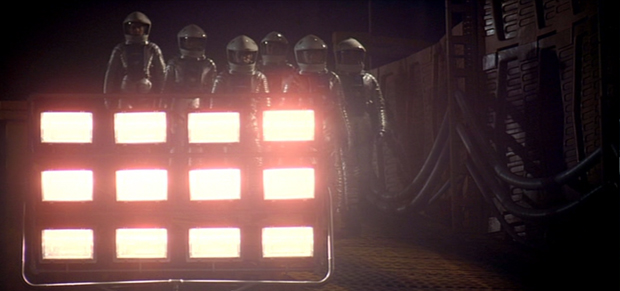
211 A long opposing shot of the astronauts entering the pit. (52:34)
This is an interesting shot as the arrangement is such that it is nearly identical to its opposing shot, 206. Most notably, the monolith, in both shots, is angled slightly toward the walk on the right of the screen. Now, this is entirely as it should be, and yet it feels both natural and unnatural. The opposing views are so much the same that with a few exceptions (such as this view not having a middle bank of lights) they feel much the same to the viewer, as if they have not switched orientation. If one does feel a switch in orientation, the position of the monolith may seem unnatural, as if it should now be angled away from the ramp, when instead its angle is appropriate.
Another reason orientation is confused is because the viewer is greatly focused on the lights. In shot 206 we see the 3 banks of 12 lights on the opposite side of the astronauts. The banks of lights on the side of the astronauts are obviously not lit (those which face the opposite direction). Our eye catches and feels for us the direction of the light and so we orient ourselves accordingly. When the astronauts are in the pit we are instead always facing the side with two banks of lights (opposite the side with three) but we will still feel as if we are facing the first presented brightly lit side of three banks of lights because we had intuited the other side was not lit. In fact, in shot 211, it's obvious that those 3 banks of lights opposite the 2 banks of lights are not lit. That side of the scene is cast in darkness. That is why shot 211 feels to us like 206, even though the landscape is different exterior the excavation, even though the astronauts are coming toward us instead of walking away. It's because of the lights. Obviously, the side with the 3 banks of lights isn't lit up in 211.
212 Medium shot of the astronauts from the front approaching the monolith in the pit. (52:50)
Heywood circles around the monolith to the left and we are shown the following view just before the cut-away.
213 Heywood seen now in an opposing shot as he comes around the monolith to the left. (53:02)
214 Medium shot of the photographer turning and righting his camera between shots. (53:09)
This appears to be the same photographer as was taking shots at the conference, younger than Bill, Heywood and Halvorsen. Where was he during the ride over? Was he the possible fourth individual in shot 203? He would have had to have been, hidden in the moonbus except for a chance glimpse of part of his helmet.
We are shown the photographer vigorously cranking the camera as he advances the film forward. I have read that the case was an underwater case (see the comments). This reminds of my earlier discussion on how distanced we are from a green earth in this film, never seeing shots of it, and even Elena speaking of her husband doing underwater research.
215 Medium shot of Heywood approaching the monolith and laying his hand upon it. (53:14)
We've had an optical illusion of sorts as Heywood approached the monolith to touch it. The reflection of lights in the lens can appear to be a kind of reflection on the dark surface of the monolith, especially as Heywood's figure interrupts the reflection and obscures part of it. All of our views so far of the monolith have shown its broader surfaces to be a flat black while the side shines. Then, the scene brightens slightly and we see items in the background where we may have supposed the flat black surface of the monolith to be. Finally, Heywood touches what is actually the side surface of the monolith.
216 Close-up of Heywood's gloved hand upon the monolith. (53:29)
217 Return to the medium shot of Heywood as shot 215. He slowly withdraws his hand. (53:35)
Shot 216 | Shot 217 |
 |  |
According to the version of the film on my computer he began touching the monolith about 53:24 and removed his hand from it about 53:39, in case anyone is interested in an approximation of the length of time.
Shot 216 presents the monolith as a dividing line, which is what we shall see in the last few frames of the movie.
The monolith, as it is presented in shot 595, is the line wherein begins symmetry and mirror reversals.
218 Long shot of the astronauts about the monolith from the perspective of shot 211. (53:44)
We view from behind the photographer. He steps toward the monolith and now gestures for everyone to gather for a group shot.
The men pull together, Heywood positioned third from left.
219 View from behind and over the photographer's left shoulder. He is gesturing for the men to move more closely together. The five stand before the monolith, Heywood in the center. (54:14)
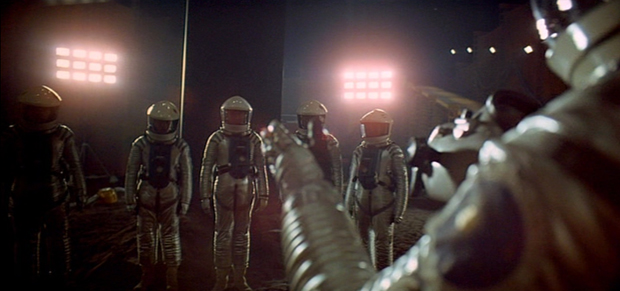
220 Medium shot from below of the photographer from the front, a bank of lights shining over the shoulder on his right (as we face him). (54:19)
He steps back and again gestures the men to move in more closely together.
Now a high piercing sound. The photographer is the first one we see react, closing his eyes in pain. Holding his camera in his right hand (as he was gesturing with his left) he raises his left hand to his head.
The half red circle observed seems to presage the coming appearance of the half-sun over the monolith. It stands out in this shot, almost luminescent.
221 Medium long shot of the five men before the monolith, from behind the photographer's left shoulder. (54:23)
He still, in this shot, holds the camera with his left hand, only now taking that hand from the camera and raising it to his ear as the other men all raise their hands to their helmets, stepping away from the monolith. The camera comes around from behind the photographer, closing in on the men before the monolith, Heywood in particular, still in the center, then draws around Heywood for a glimpse of his face as he looks back at the monolith and up.
This is actually a brief drop back in time, indicated by the photographer still holding the camera with his left hand. Kubrick forms a pattern of these drop-backs in time co-incident with the appearance of a red half-orb but I will delay on writing about this at length until shot 294.
222 Shot from below of the conjunction of the monolith with the sun and crescent earth. (54:33)
What we are viewing here is of course impossible. We have already seen the earth was just above the lunar horizon and the sun also off somewhere way to the side, not directly overhead. Neither earth nor the sun are directly overhead. This is an impossible viewing, just as was the conjunction that occurred with the hominids.
Comparing the conjunctions observed thus far, below is the one observed by the hominids and beneath that the one observed by the audience, presumably from the moon, at the beginning of the film.
THE PHOTOGRAPHER
I'm going to go back and take another look at the photographer.
So, I had gotten to the end and of this segment and had really become aware of the photographer when the troupe started down the ramp toward the monolith and the camera took up a position behind the first three men, from approximately, but not at all exactly, the same area as the photographer, in that he he was following up the first three men. That is when it hit me. "The photographer is with them but he isn't shown coming over on the moon bus with them." And I went back to check and that was when I found the fourth seeming head-helmet in shot 204.
Let's return to the appearance of the monolith in The Dawn of Man. I had written of a kind of outcropping of rock to the side, that the camera kind of hides behind, looking out on the scene, and it gave the feeling to me of a third presence, an objective non-participating, observing presence.
We'd had this shot the night before the monolith appeared (above) and then the morning of the monolith (below).
I had compared it to Wendy's encounter with Jack, when he steps out of nowhere into the Colorado Lounge after she's freaked out over his page in the typewriter in a very obviously monolith-style shot.
I had briefly noted how this was an important shot to Kubrick. He had spent time setting it up in the first part of Dick's drive to the Overlook, creating a similar black silhouette to Jack's in Dick's car, that sometimes seemed like a back seat passenger in the car rather than Dick's reflection in the rear view mirror.
This is something I had explored in some depth in my analysis of The Shining and how when Jack appears out of nowhere it is from the area where are the bulk of the photographs in the lounge.
At first glance there's nothing to tie these images to the shot on the moonbus, from behind the seat, as they head over took at the monolith.

Except it's one of those discreet style shots, the seat serving as a dark and overbearing cover on the right from behind which the camera peers. The way that scene is set up, Bill serving only Halvorsen and Heywood sandwiches, never looking beyond them both, we are intended to understand there are the two pilots up from and only three passengers to the rear: Bill, Halvorsen, and Heywood. But then we get to Tycho and there's the photographer who was also at Clavius. Seemingly the same young photographer who Kubrick had focused on kicking off the conference section, he taking shots of Heywood, Halvorsen and Bill, who had then left the room. And we question, how did he get over to Clavius? There is one moonbus. Certainly he would have had to come over on the moonbus. His would have to be the seeming fourth helmeted head briefly glimpsed over Bill's right shoulder as he returns from the front of the bus where he's observed with the two pilots.
It is much the same set up as in The Shining. In The Shining Kubrick sets up this shadow presence, presumably Dick's reflection, but it also can be viewed as a back seat passenger in the car. This same shadow presence, after Wendy's monolithic encounter, steps out from behind the wall of photographs and becomes Jack, who surprises Wendy as he was nowhere in evidence earlier, he was not back in that area. Here, in 2001 we have that shadow rock accompanying the first sighting of the monolith. When Heywood, Bill and Halvorson are in the moonbus, riding over to look at the monolith, we have the shot of Bill from behind the seat, setting up again somewhat the same feeling as had with the peering from behind the rock during the first encounter with the monolith. Then suddenly there is the photographer at the monolith site, and we look back and find that the photographer was an invisible presence on the moonbus, not intended to be perceived, not intended to be thought of as being on the moonbus, invisible.
One could perhaps look at this surreptitious shadow presence as stepping out of the shadows here.

It seems to me of some significance that the photographer is the first person who is shown to be struck by the piercing sound of the monolith, as he takes his shots of the group. We are never given an explanation of what exactly triggers the monolith's sending of its signal to Jupiter, but the excavation process isn't the cause, or simply being in the presence of humans. Heywood's touching the monolith doesn't seem to be the cause, else why wouldn't the piercing noise have begun then? Instead, the piercing noise begins coincidental with the cameraman. Why does the event occur now, presaged by the orange-red half circle beside the photographer, and why is the photographer shown first affected in shot 220 and then appears not to be in 221? These are questions to which we'll return later.
UPDATE 21 SEPT 2022: Grant Hutchison writes to inform me that 2001 Italia reveals the photographer, played by Burnell Tucker, is also the co-pilot of the moon bus. 2001italia states that though it's difficult to tell this in the film, continuity shots show this to be so.
And the hairstyle of the co-pilot in the movie appears to be the same as seen on the photographer.
Before continuing, I'll note that the pilot and co-pilot of Floyd's two previous flights shown in this section are so alike one another that they are veritable twins--and there are times that Frank and Dave are presented in a twin-like manner--so Kubrick breaks with this soft symmetry with the pilot and co-pilot on the moonbus appearing very different. They have different hairstyles, and the pilot's hair is lighter than the photographer's. They are easy to tell apart.
That clears up the mystery as to how the photographer got to the monolith, which I previously thought was explained by the seeming glimpse of a 4th helmet on the bus.
But that ends in making the appearance of the 4th helmet even more mysterious.
Hutchison writes me back saying that perhaps what we don't see is that the helmet is being held out for Floyd by the person. Could be!
I pay attention to this because the role of the photographer/cinematographer is always something to study in Kubrick's films for its complexity in its commentary on the filmmaking process as well as the relationship to the audience. In A Clockwork Orange the relationship of the set/story to the audience and filmmakers was theatrically prominent throughout. At the end of The Shining it is a photograph that closes the film with a new mystery concerning Jack, and the hotel is a gallery of photographs, most seeming ordinary, others less straight-forward. All that photography within the cinematography and only at the end do we get a clear view of one of those images. In Full Metal Jacket, a theater appears in Hue, following a section in which filmmakers shoot a documentary that the soldiers dub, Vietnam: the Movie. We accept this movie theater, but if we give it any thought, it shouldn't be there. In the context of the environment, it's an impossibility. The theater instead, at least on one level, has to do with the preceding documentary, and the relationship of the audience to the film, as well the camera, director and company.
Anyway, for my own reference, and if you're into it, here are some screengrabs of the rear of the moonbus that show maybe four people, or three people and a helmet being possibly held for Floyd to put on. These screengrabs are from several passes through and aren't sequential. The last thumbnail at the crater is just so one can compare with the variety of perspectives of the helmet caught in that shot.
 |
 |
 |
 |
 |
 |
 |
 |
 |
 |
 |
 |
 |
 |
 |
 |
THE AUDIENCE AND PART THREE
The Dawn of Man, as far as the original viewing audience could tell, had nothing to do with Heywood's trip to the moon, with the exception of the monolith, and that was alright. The Dawn of Man was prehistory. But what Kubrick did, shifting now to The Jupiter Mission, was rather extraordinary, for he abandoned everyone in this second section. The audience was beginning to build an attachment to Heywood's story, and now he is completely dropped. His little girl is dropped. No more of Heywood as a central character, no more home life of Heywood, nothing more about any of the other characters we met in this section with whom we've spent the last 35 or so minutes. This kind of rupture was fairly novel, to absolutely drop everyone and an hour into the film bring in a whole new cast, and it was completely disorienting story-wise at the time.
tl;dr. What happened other than the earth and sun convergence over the monolith which everyone already knows about?
As with the marvelous convergence in the first section, the one of the earth and sun above the monolith also did not physically happen and Kubrick goes to some lengths to show the audience this. Yet, for decades, audiences have believed it was a real occurence and ignored the rest of the information Kubrick has given them, which demands a deeper look at an already complex film.
Jan 2014. Approx 15.600 words or 33 single-spaced pages. A120 minute read at 130 wpm.
Return to the top of the page.
Next: Part three
Return to Table of Contents for "2001: A Space Odyssey" analysis
Link to the main film page for all the analyses
